#i used the old camera because it has a wider field of view
Explore tagged Tumblr posts
Text

The skirt made from thrifted fabric is a good match for this sweater a friend surprised me with last year
48 notes
·
View notes
Note
Recently I took a panorama of the Pittsburgh skyline at night that got a positive response. That was done on the spur of the moment with an iPhone. I want to do that again and more, but this time with a dedicated camera setup. It's been years since I've had one, so I'm basically starting over again. I'm mostly interested in getting day and night cityscapes, and maybe the carryings-on at this year's Anthrocon. Would you have any particular knowledge to pass on as I set off on this journey?
Since you didn't specify a budget I'm going to assume it is in the $10K range.
And you're probably thinking I'm going to suggest a Leica. Every dentist and his brother (who is also a dentist) gets a Leica. But I just can't take a camera brand seriously when they charge you an extra $2200 for the privilege of not being able to shoot in color.


Sure, you can hit a single button in Lightroom to get B&W and save some money, but then you won't be able to brag about how limiting yourself to only shades of gray has opened up new artistic pathways in your brain while a clueless person responds in mumbles during their root canal.
What you really want for your landscapes is a Hassie.

They were the first camera on the moon! How could you *not* want a Hasselblad? That is some camera gorgeousness right there. And it's so reasonably priced*!
*compared to their previous $40,000 camera systems.
And if you are doing landscapes with the Hassie you'll need a nice wide angle lens to go with it. This one is actually quite affordable*!
*compared to their previous $8000 lenses.
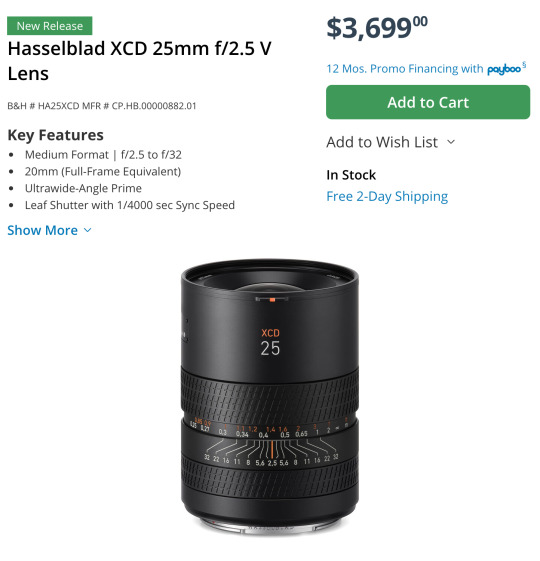
Can we all agree that is a work of art? They even use their H logo as the knurling.
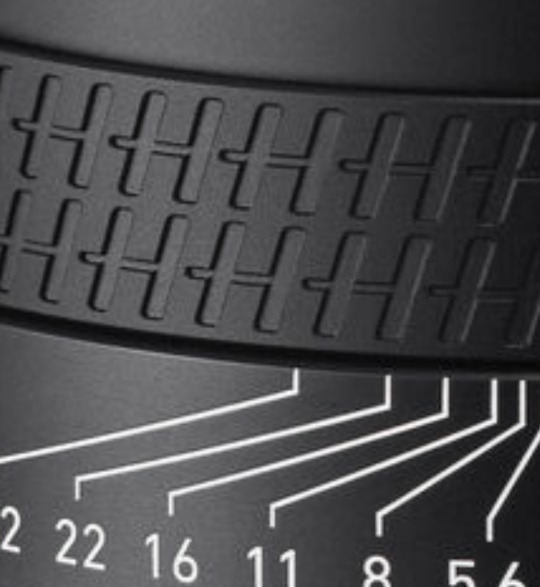
That is just so... extra. And I love it.
Out of the entire alphabet I've heard Hs give you the best grip.
Man, I almost wish I was a dentist just so I could buy a fancy camera.
Sorry... I was just having a little fun.
I never get to recommend the super cool expensive cameras. Because, ya know, the economy and the fact that only dentists have Hasselblad money.
You probably think I'm being silly but there actually is an entire community of dentist photographers keeping the high end camera market alive.
Okay, let's get started...
Landscape Buying Guide
Opening Thoughts
For landscapes I would highly suggest a full frame camera and a high quality wide angle lens.
Full frame has several advantages but it is not necessary. You can go with a smaller sensor like APS-C and get great images. Personally I would not go any smaller, but there have been some great landscapes taken on micro 4/3 and even smartphones. Technique, knowledge, experience, and composition will usually win the day over a camera, but having a nice camera makes things a lot easier.
At this point, with full frame options being very affordable now, the main reason to get a smaller sensor is if you want a smaller system that is easier to carry for extended periods and easier to pack when traveling. Or if you aren't sure you want to take on photography as a hobby, you can get an old APS-C DSLR for under $200 to learn with and test out.
So if you need a very cheap OR very compact system, APS-C and Micro 4/3 might be worth considering, but a bigger sensor will cause less frustration most of the time.
Froggie Note: The expensive Micro 4/3 and APS-C systems are the compact ones. The cheap systems are about as bulky as full frame.
The biggest advantages to full frame are low light shooting, lens selection, and field of view. Full frame cameras have many, many more lenses to choose from. And since the sensor is bigger, it is much easier to get a wider field of view that is often needed for landscapes. And the high ISO noise performance tends to be better on full frame.
However, you can use full frame lenses on APS-C camera bodies within the same ecosystem. They just get a little... zoomier. Roughly 1.5x zoomier. A 35mm acts like a 50mm, for example. So if you want to spend a little less now you can get an APS-C camera with a full frame lens and then upgrade to full frame later on without having to buy a new lens. Full frame lenses work on APS-C bodies but not the other way around.
Most landscapists have a really solid 16-35mm lens and that covers almost all of their needs. So I would suggest something comparable. Please don't get suckered into some crazy 18-300mm superzoom. Just get the focal range you need for the photos you want to achieve.
A purpose-built lens always outperforms one that was made to do everything.
As far as where to get used gear, I highly recommend using KEH or MPB when buying used camera bodies. They check every device and offer between 3 and 6 months warranty to make sure the device won't crap out on you. Lenses are typically a lot more robust and a safer thing to buy on eBay or Facebook Marketplace if you can find a better deal. But the security of having a warranty and a return apparatus if something goes wrong might be worth the extra price when using these two sites.
I am going to recommend Canon, Nikon, and Sony systems. I feel they have the most complete ecosystems with gear that spans all budget ranges. I'm not saying there aren't good cameras from other brands, but you have to remember every camera has an ecosystem surrounding it. There are accessories and upgrade paths and niche lenses that may not be available with other brands. I think Fuji has some tempting options and if you like the look of vintage film photography, their emulation options are quite stunning. Their cameras are also quite attractive and have very satisfying knobs. But I still can't recommend them unless you have a specific reason for wanting their gear.
Just remember that for every Canon DSLR I recommend there is a comparable Nikon option available as well. There are more lenses for a Canon full frame DSLR body than any other brand with Nikon coming in a close second.
So if you choose not to go mirrorless yet, the Canon and Nikon DSLR camera ecosystems are immense and have tons of gear and accessories available to go with them. And since used gear holds up really well, those ecosystems will survive for decades.
Should you buy a mirrorless camera or a DSLR?
Mirrorless cameras are the latest camera technology for interchangeable lens camera systems. At this point they are superior in every aspect and they continue to improve year by year. Because of that, used DSLRs have plummeted in price. This allows people greater access to a starter ILC (interchangeable lens camera) without a significant investment. You can get professional quality images on either format, but mirrorless has a shallower learning curve and much better automatic modes.
The in-body image stabilization (IBIS) stabilizes *every* lens and the eye tracking autofocus make "focus and re-compose" extinct. These are huge selling points for a lot of people. With IBIS you can take photos with up to 2-4 second shutter speeds without a tripod. And never missing focus on a human or animal or bird is pretty cool too.
DSLR camera bodies are no longer being designed by most of the major manufacturers. Thankfully Canon and Nikon developed plenty of bodies and lenses, so you will always have options and upgrade paths. But you will not be able to upgrade to systems with the latest advanced features.
The best DSLRs available are probably the Nikon D850 and the Canon 5D Mark IV. That is as good as it will ever get. The technology ends there. So if you want to enter an active camera ecosystem then you will have to get a mirrorless camera.
DSLR Camera Systems
Full Frame DSLR Camera Bodies
Canon
If you buy a used DSLR, there are some very affordable full frame options. In fact, the classic much-praised budget full frame Canon 6D can be had for under $300 right now.
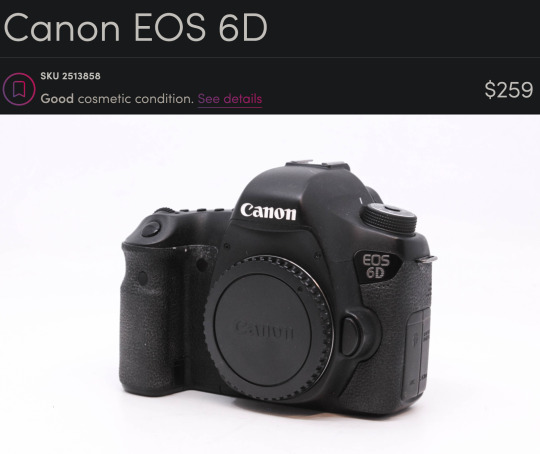
This is an old camera. It has no fancy features. It only has 20 megapixels. It just does what it says on the tin. But it has a big sensor and a *ton* of really cool lenses available for it.
If you are specifically looking to create really high resolution panos, you could also look at the 50 megapixel 5DS R for around $1000.

There is a community of landscape pano-maniacs that love to create "gigapans" that have endless amounts of detail where you can zoom in and find new details in every photo. I was only able to create a 120 megapixel photo, but you can still find things like people starting a campfire and a dude fishing and a truck on a far off bridge. So even though this seems expensive for a DSLR, you are looking at another thousand bucks to find anything with more megapixels than this bad boy, so it is quite a good deal relatively speaking.
Nikon
Probably the best DSLRs ever made were the Nikon D800 series and you can get the Nikon D800 for $464.

This is a newer camera than the 6D with more megapixels (36) and a better sensor. It also has a more modern autofocus system and about 3 more stops of dynamic range which can come in handy for landscapes. This is an incredible camera for this price.
APS-C DSLR Camera Bodies
If you aren't sure you want to commit to this hobby, you can look into a Canon APS-C sensor body like the Canon Rebels and Canon 60D through 90D models and get good results.
And there are many Nikon DX APS-C bodies that would be great starter cameras as well. If you get a Nikon, you'd have an upgrade path to the D800 if you get hooked by the photography bug. I would miss a few very special Canon lenses like the 100mm f/2.8L macro and the 400mm f/5.6 telephoto but I'm sure I could figure out some reasonable Nikon alternatives that would do roughly the same thing.
Canon APS-C
There is a Canon 60D for $139 right now that would be perfectly adequate for landscape work on a tripod.
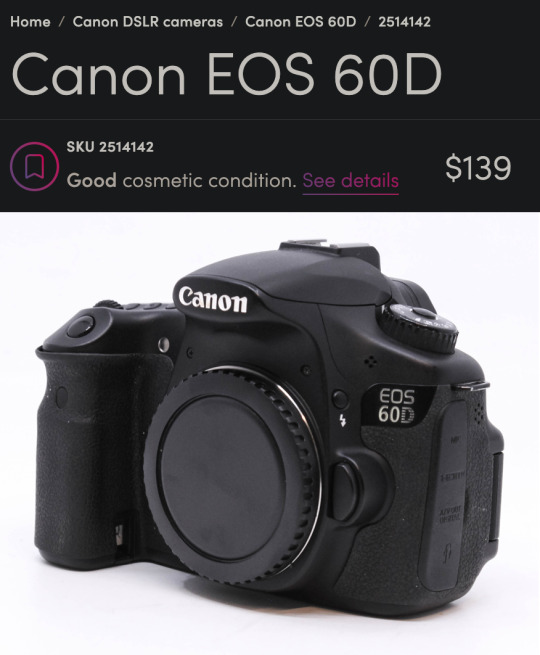
That was my first camera and I took some very nice photos with it. Only 18 megapixels but it has a very convenient flippy screen which was really helpful for a disabled photographer trying to get low angles.
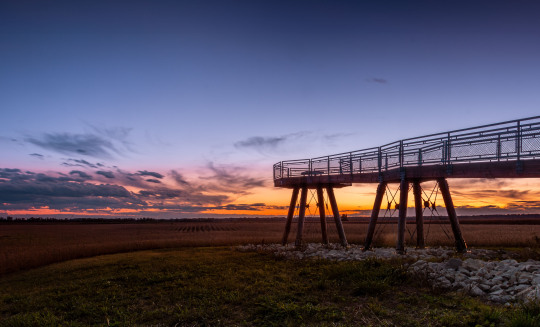
This was in 2014 and I didn't know what I was doing but that is a pretty stellar-looking sunset for a (now) $140 camera.
Nikon APS-C
And the Nikon D3400 would be a great option as well at around $184.

You get some extra megapixels (24) and it is a bit newer than the Canon. I get the sense that used Nikon DSLRs give you more value for your money right now but I don't have a large enough sample size to confirm that.
Full Frame DSLR Lenses
Froggie Note: I am recommending full frame lenses even if you choose an APS-C DSLR body so you have an upgrade path. But also very few purpose-built APS-C lenses had superior glass. Just remember, crop sensor APS-C cameras add ~1.5x to your focal length. So a 16-35mm will have the equivalent field of view of a 24-50mm lens. Still quite acceptable for landscapes, but you may benefit from doing panoramas more often. And if you upgrade to full frame down the road, you'll already have the ideal lens.
Canon DSLR Lenses
If you get the 6D or another Canon you could pair it with the beloved-by-landscapists Canon 16-35mm f/4L.
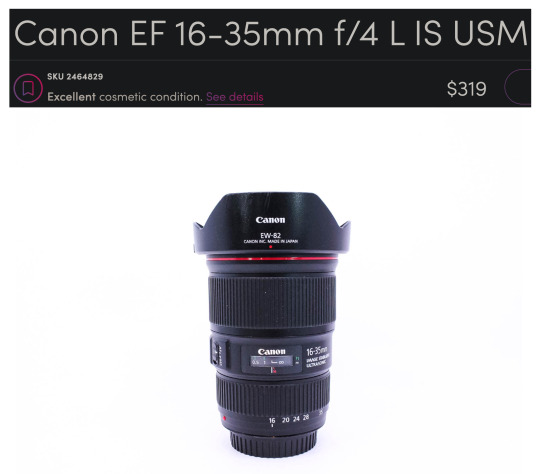
Honestly, it is blowing my mind you can get that combo for under $600. Me from 12 years ago is super jealous right now.
If you are worried you might need something to work in lower light and still want a zoom, the f/2.8L starts at around $434.

This might be the most famous landscape lens of all time. Kinda boggles the mind how many gorgeous vistas this thing has captured the light of.
If you can live without the zoom, you could get a much sharper prime lens that can also be used in even lower light. A used Sigma 24mm f/1.4 Art lens is $439 would be a fantastic option.

24mm is still a very good focal length for landscapes and the sharpness of this lens lends well to panoramic stitches. Seriously, these art lens are so freaking sharp. Although 35mm is typically preferred for most street photography, I think this would do great for that purpose as well. It couldn't do close up portraits, but 3/4 and full body portraits would look great. I also love this focal length for doggos. It enlarges their heads a bit which enhances adorable-ness.
Though I probably wouldn't recommend the 24mm on APS-C for landscapes as it would put you near a 40mm full frame equivalent field of view.
Nikon DSLR Lenses
And on the Nikon side of things you could get the Nikkor 16-35mm f/4 for $399.
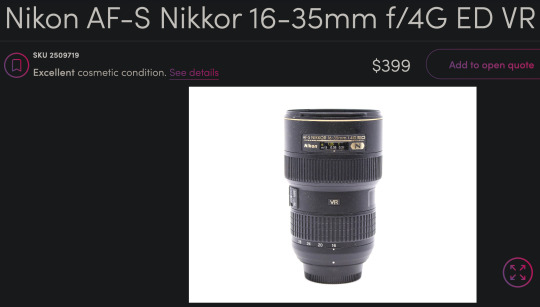
This is a great lens too. Very comparable to the Canon L glass. And paired with that D800 you would have a better shooting experience than with the 6D if it fits within your budget.
It's a little harder to find, but you can also get that same Sigma 24mm f/1.4 Art lens for Nikon at around $528 used on Amazon and in the $400 range on KEH and MPB when it is available.
The older and softer Nikkor 28mm f/1.8 is a little more affordable and easier to find.

What if you are not a dentist but are willing to save up for something a little nicer?
Enter the world of...
Mirrorless Camera Systems
Sony currently has my favorite ecosystem of mirrorless cameras and lenses and they are consistently ahead of the other brands as far as technology and features. In fact, many other manufacturers use Sony sensors. They literally supply their competition with their own tech. They are also pretty good about updating firmware—even with older models. So I feel like Sony has a lot of future-proofing advantages over other brands. Sony has a great selection of 3rd party lenses like Sigma, Tamron, Viltrox, Laowa, Samyang, etc. These lenses often have nearly the same optical quality as Sony's G Master lenses at a fraction of the price.
Full Frame Mirrorless
Currently, I think the best value full frame mirrorless camera for landscapes would be the Sony a7R III.

This is very nearly a top-of-the-line landscape camera for a little over $1200.
That might sound like a lot, but I want to be clear...
This isn't just decent. This isn't "good enough." This is a spectacular professional grade full frame camera.
10 years ago you could spend $6500 for a *worse* camera. 5 years ago you could spend $3000 for a *worse* camera.
It can do every genre of photography except for maybe fast paced sports/action. It has an amazing 42 megapixels—which are not necessary but they do make editing and printing a lot less of a headache. The file sizes can get a little big, but storage is a lot cheaper than it used to be.
Oh, and it can be used for professional quality 4K video work too.
The a7R III comes with all of the modern bells and whistles including in-body stabilization (IBIS) so you can handhold at very slow shutter speeds. It has one of the best autofocus systems—complete with eye tracking. But not just human eyes! Dog eyes. Cat eyes. Bird eyes. If it has an eye, the Sony can probably lock focus on it. And it has an admirable 10 fps burst shooting mode.
APS-C Mirrorless
If you want to enter the Sony ecosystem but can't afford full frame quite yet, you could do the a6400 for about $600.

You still get the eye-tracking and the in-body stabilization, but you will lose some image quality at higher ISOs due to the smaller sensor size. However, you can get the same full frame E-mount lenses for it and upgrade to a bigger sensor later on and not have to buy new lenses.
Mirrorless Landscape Lenses
I think a good value landscape lens would be the very impressive Tamron 20-40mm f/2.8.

This is a newer lens so there aren't many deals on used options yet. But this is still a great price for the quality and versatility you get. You will never regret spending a little more on glass.
The 20mm range can fit an entire cityscape in the frame without needing to do a panorama. But if you zoom to 40mm and mount the camera vertically, you could stitch together several photos to get well over the 100 megapixel range.
Also, the 40mm focal range is long enough to do street photography and even head & shoulder portraits. The wide f/2.8 aperture combined with the high-ISO friendly full frame sensor and in-body stabilization means you can shoot in very low light without a tripod. You can also get some great pictures of stars if you travel to someplace with minimal light pollution.
The cheapest landscape zoom lens I could find was the Sony 16-35mm f/4 at $384.
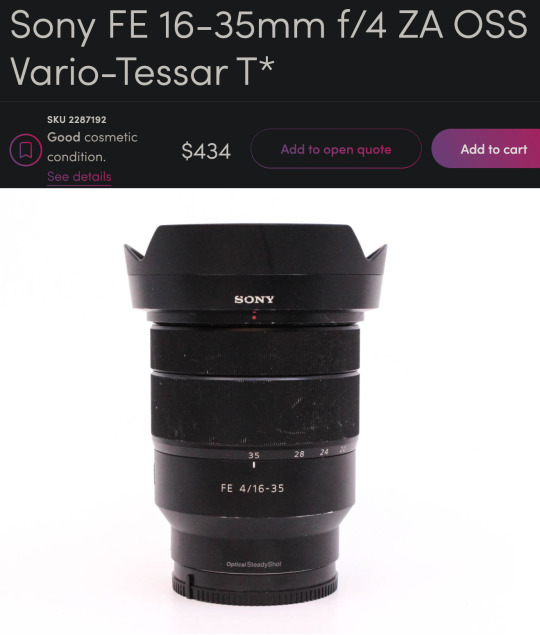
It's one of Sony's older lenses and may not take advantage of all of the a7R III's pixels, but it would be a good option to get you started in this system and upgrade the lens later on.
Mirrorless Prime Lenses
Zoom lenses are great but you have to spend more to get tolerable quality. Kit zooms can be softer than even the tiny plastic lenses on your phone. So a great way to stretch your budget is to get multiple fixed focal length "prime" lenses. Primes can be built inexpensively while still having good low light performance and decent sharpness.
For instance, you could start with something like the Tamron 20mm f/2.8 for $175. And if you want to do more than landscapes you could add the Sony 50mm f/1.8 for $170 later on. Cheap primes will outperform any of those mediocre kit zoom lenses in that same price range. You lose some versatility and have to deal with the pain of changing lenses or zooming with your feet, but sometimes a tight budget demands a little pain.
There is also a higher quality 3rd party wide angle prime lens that is very popular right now. The Viltrox 16mm f/1.8 is only $549 and the reviews say it has similar quality to lenses 3 times its price.
If you have to choose between a better camera body or a better lens, a good lens will help your photos more than a fancy camera body.
Froggie Note: These are examples. You should always do your own research before making a major technological purchase. This post could be a year old by the time you see it and there could be new stuff that is better. But all of the principles I tried to convey should hopefully guide you to a good decision. Also, feel free to message me if you want to ask about specific gear you are considering purchasing.
More Resources
This is my Encyclopedia of Lens Terms which is a helpful primer in understanding all of the wonderful and different lens options available on ILCs.
This is my buying guide for low budget used DSLRs. Similar to this post but less geared toward landscapes.
And this guide for getting decent landscape photos with any camera.
This is a free tutorial that teaches you everything you need to get started with an ILC system.
youtube
And this free tutorial by Karl Taylor is quite good as well.
70 notes
·
View notes
Note
hi hi!!!
I'm a CFX artist (I do hair and cloth for 3D animated movies) and I wanted to clarify something!!
the encanto post? we talked about that one at length at work when it was first made, and it is incredibly evident that the guy who posted it is just bad at his job. the exact same effect can be archieved by changing the camera focal length- but animators never reach for technically competent solutions. (this is a roast.) and even if thats not possible, there is NO reason for why her shoulder area or chest are completely crushed or why her feet are inside of her hip bone.
and also, since I am in the department that comes right after animation- if I had gotten that shot, I would have either sent it straight back to the animator to fix it, OR cleaned it up myself, by which I mean it absolutely did not look like this off-camera by the time we send it for final light render.
essentially if animation looks that messed up off-camera, it is not "animation magic", it is actually someone doing a bad job.
I'm going to have to respectfully disagree.
For one thing, the behind the scenes image was not close to a final render so I don't think you can fairly judge what was probably just the animator lining up and blocking the shot. I don't think at that state they were concerned with the shoulders, chest, and feet. I'm betting the final polished version looked much better.
And I also disagree the exact effect could be achieved by changing the focal length.
As a photographer, focal length is not just about cramming everything into the field of view. I don't only use a wide angle because I want more stuff in the photo.
It is also an artistic decision.
Wide angle lenses exaggerate distance and can make foreground objects seem massive and background objects seem tiny.
Look at this super wide angle shot of Otis lusting after a tennis ball.
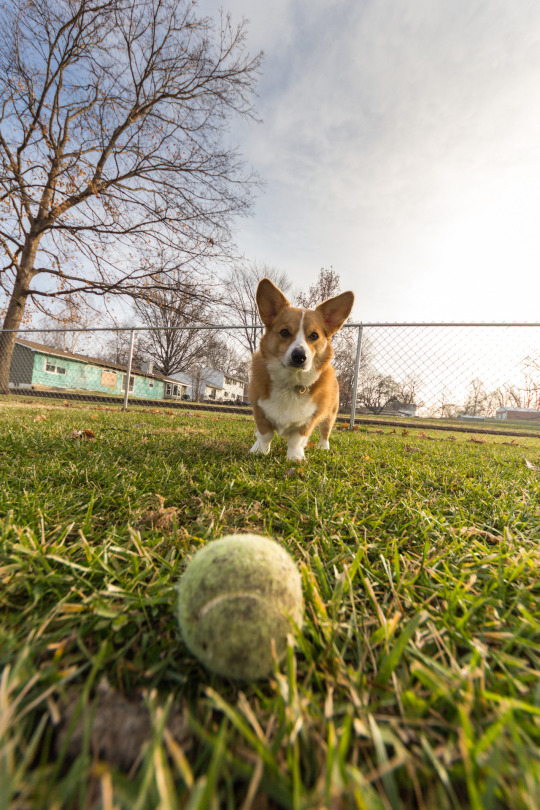
The ball has a huge presence in the photo. It is only two feet away, but the distance between them seems immense. The ball takes up as much space in the photo as Otis.
Compare that to the ball in this telephoto image.
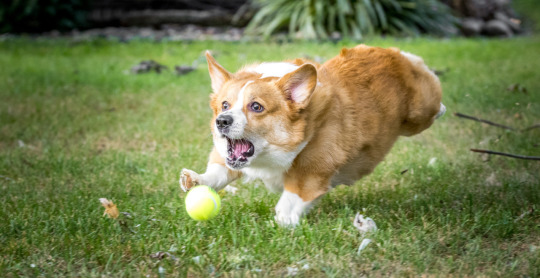
The picture now becomes less about the ball and more about the act of chasing it. The ball is literally only a foot closer to Otis, but it has no commanding presence like in the super wide shot.
So what artistic intention comes from using a telephoto lens like in Encanto?
Telephoto focal lengths compress distance. Background objects appear much larger in the frame. They also flatten the face and give a more flattering perspective of said face. Human faces can look a bit alien at wider focal lengths.

So what if you want the background to look large and encompassing and you want the flattering facial proportions from a telephoto lens, but you also want a foreground object to have a commanding presence like the ball?
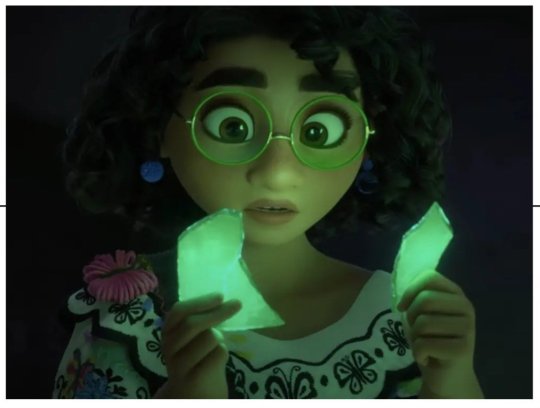
You cheat!
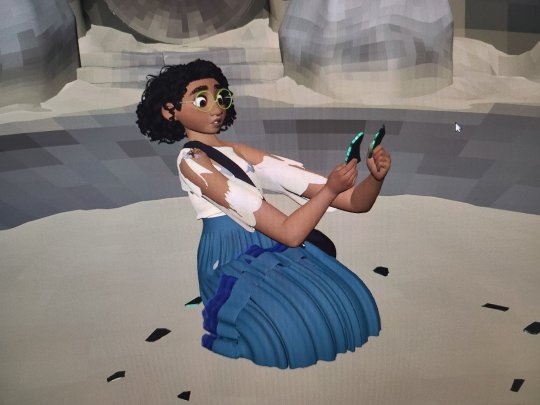
This is not a technique confined to the world of 3D animation though. It is actually an old live-action trick. They will actually use another person's hands to do effectively the same thing as above.
In Hellboy II, Guillermo had two problems. He wanted a telephoto feel and depth of field and he also wanted a very intricate practical egg prop that could open mechanically.
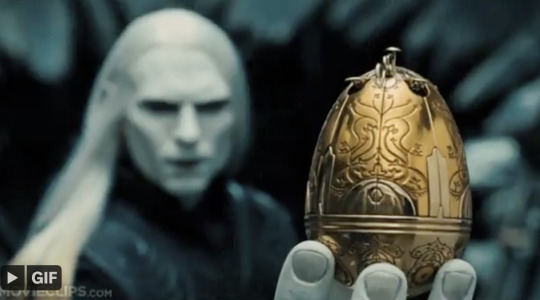
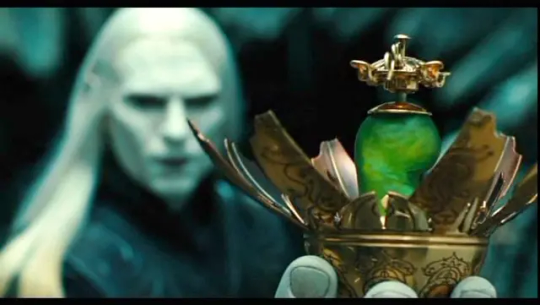
To get the proportions and the framing and the feel of the shot as intended, he double cheated!
He made a big freaking egg with a big freaking fake hand.
(I know there is a picture of the giant hand somewhere but my googling failed me.)
In any case, I think this is just a case of good problem solving over incompetence. I think the director or the animation lead wanted this scene to fit within a specific focal length and it was easier and more efficient to just give her crazy long arms.
I'm not trying to dispute your expertise or animation-splain. Perhaps there was a better way to achieve the same look. But if the final result looked good, I don't think we need to bash someone who was probably under tight deadlines and had a lot of other work to complete. At least not without a lot more information.
55 notes
·
View notes
Text
Video Surveillance Log #110809112
Log Transcription Begins:
View: Exterior Of Former O5-12 "Adam" retirement lodging, located [███████,██], at 11:██pm, View switches to the lodgings exterior barn. Where Former O5-12 is seen teaching a young man to work on cleaning the barn. The cameras detect anomalous interference, easily traceable and is quickly cleaned up, after 50 to 60 seconds of footage, the shot slowly starts to distort with static, however the view of former O5-12 "Adam" and the young man remain in focus as The former Overseer seems to be reprimanding the young man. The last frame visibly uncorrupted is the Former Overseer swinging his cane at the young man before the footage is ruined with static.
Several motion sensors picked up activity in the woods surrounding the house leading west. After approximately two hours a anomalous fluctuation is detected some miles away from the property, The young man in question was Alexander Quinn Silendit, a known Member of the Bright Family. Rumours State that Former O5-12 "Adam" took in Alexander as a means to reconnect with his Fatherly side. There were rumours that things were not as the former Overseer stated, but these rumours were never investigated until after the former Overseers unexpected demise. Alexander Silendit has been classed as a Possible Keter and id on the loose with unknown anomalous capabilities. If any reports involving static come through, please alert your site director and a mtf squad will be sent to investigate. Repeat, Alex Silendit is Loose and has Unknown Capabilities, if spotted in plain clothes do not engage. Report immediately and Back up will be on its way. Trackers were implanted, however any and all attempts to establish a signal lead straight to the point where the source of the anomalous field emenated from. Location: Unknown.
Adventure Log Entry #Who cares. Im free.
Uhhhhh so, I have no idea where I am, All I have is the clothes on my back, and AND I have his shitty cane. Sweet. Cool, where did this neighbourhood come from and how did I get here? Are any of these h- Oh sh-
Ad- Oh fuck that Dear Diary, its been two days, and whatever those things were, no im seein things obviously, ok cool a cul de sac, a nice little area, lets try one of these doors.
Diary Log #7 Wow there really aint shit around here is there? However I did find a house that was condemned for a bee infestation. That was wild. Thought I was goin crazy because it sounded like the wildest frat party Id heard ever. So thats a thing. Gonna try talking to the house and seeing what happens.
Diary Log #13 So... Ive made friends. With the bees. Thats a thing. Only took oh sixteen stings, two offerings of apples that I found. And literally trying to static every piece of workable technology to match the swell of the buzzing to make a point. But! They at least respect me now. And will occasionally sting intruders to the cul-de-sac. I think this... this is home now.
Diary log #32 Well. I managed to get A. ONE conputer monitor. Ive managed to hook it to an empty ethernet port. Ive never... really tried to connect to anything before. I wonder how hard that is. Could I... Become my own wifi router. I know I can type and click but... Can I really force the signal into the wider world. Where is the wider world? Right thats too many existential thoughts. Just focus on the task at hand and you will succeed. Thats what the old man said right. Right?
Diary Log #69 Haha Nice. Anyways promising results finally. Got my first memes to come through which means. Im home free. I can finally stop using this. Probably wont though. Its like saying hi to myself. From the past. I miss people.
1 note
·
View note
Text
Demon’s Souls || 2020 Notes [1]

While replaying Demon’s Souls I thought it’d be fun to describe some of its special qualities and certain differences between it and the Dark Souls series. The latter has almost completely overshadowed the former, to the extent that the first Dark Souls is often treated as the starting point for FromSoftware’s post-PlayStation 2 output, so it is now arguably more worthwhile than ever before to, you know... acknowledge Demon’s Souls’ existence.
• It is a little ironic that the visually darkest of the Souls games is not any of the ones with “Dark” in their title; it is, in fact, Demon’s Souls. Demon’s is full of spaces with utter or near-utter blackness, spaces which only reveal their structural character until you’re a step away from a wall or colonnade. This is an exciting quality on its own, one that makes the areas you’re navigating retain a sublimely threatening aspect separate from that of the mortal threats the enemies pose, and it becomes especially exciting when comparing it to Dark Souls 3′s inappropriate brightness on even its lowest lighting setting.
• Relatedly, Demon’s Souls is the only one of these games which bothers to explain your character’s illuminative capability: a small, brightly glowing stone (perhaps a good luck charm and a practical item) is attached to their hip. Dark Souls 2 and 3 and Bloodborne allow torches to be used (Bloodborne, too, a lantern), but your avatars otherwise exude an inexplicable light.
• The Dark Souls series represents a break from Demon’s Souls’ level design not just by way of its variously realized interconnectivity but also by distancing itself from constricted meandering layouts. Although Demon’s Souls’ areas are organizationally diverse -- one couldn’t be mistaken for another --, there are pervasive architectural motifs such as halls no wider then your person, slim towers or verticalities with staircases or planks tightly winding up and down the walls, and bits where you can miss a thin portal or doorway by not swiveling the camera around your entire immediate surroundings. This is, perhaps, one consequence of differing staff on level design and of Demon’s Souls’ adjacency to the King’s Field series.
• I’ve written before about how adventurous Demon’s Souls is with its boss fights, and I’ll write about it again! Oftener than not, bosses’ rooms are extensions of the preceding level design, rather than stripped down, isolated rings. Think of the church wherein the False Idol appears: this is a struggle where offensive tactics assume equal importance to weaving around the obstructing pews and hiding from magical projectiles among the side aisles. For this trend, we might be able to partly thank a lack of confidence in the mechanics sustaining head-on, arena-based fights. It is also notable that a number of bosses have fairly passive designs (e.g., Phalanx, Adjudicator, Storm King, Maiden Astraea, the Dragon God in its final phase, or King Allant). Opponents can be vulnerable and pitiable, creating an emotional variety and accentuating the narrative of us being the “demon” in the game’s title.
• Demon’s Souls doesn’t allow you to access the Nexus, the game proper, without firsthand experiencing your own death. Dark Souls shows your person as having already hollowed; Dark Souls 2 marks your entry into Drangleic with a cinematic wherein you pass through the threshold of a vortex; Dark Souls 3 shows you rising from your grave. Bloodborne may be the closest to Demon’s Souls: most of us will have likely died our first before coming across a lamp, and thus will be introduced to the Hunter’s Dream -- Bloodborne’s home base -- by death; but this is still unlike Demon’s Souls, which establishes a significantly fatalistic atmosphere with this moment of utter requisition.
• With its visuals’ technical effects (e.g., the warm, distinct halos surrounding candles’ flames), the muted palettes, and the plain attire of other characters and architecture -- often severe, and lacking any ornamentation or just minimally articulated -- Demon’s Souls recalls King’s Field IV. Monolithic sites and structures can impress a domineeringly absolutist effect by their scale and degree of aesthetic anonymity/repetition, and Demon’s Souls’ architecture utilizes this effect in places like Stonefang Tunnel, the Tower of Latria, and the Boletarian complex to create a world capable as much of intimidating as it is of suggesting monomaniacal psychologies and historical dramas.
• Demon’s Souls has the unique, relative to the Dark Souls titles and Bloodborne, contextual mechanic whereby your person can mount a higher tier if you continue walking against the designated rise in terrain. Fall damage is also drastically slight, so you can fall farther distances and survive. To me, these two particularities create a subtly broader sense of exploratory possibility that you don’t get in FromSoftware’s later Eurocentric games, despite Dark Souls’ addition of a running jump mechanic. This sense of possibility is not proportional to what you can actually do; rather, it is about what you feel that the game might allow you to do.
• For a miscellaneous conclusive entry: I went through the 2009 reviews for Demon’s Souls on Amazon a while back to see what English-speaking/writing people were comparing it to. Nowadays, we have the bland, readymade term “Souls-like”, but, a decade and several months ago, Demon’s Souls seemed to many people outside of Japan to have come out of nowhere, making their likenings interesting to read (of note, too: even among the 800+ reviews, spanning from 2009 to 2020, King’s Field is mentioned less than ten times). I recognize that the image is blurry, and have, for accessibility, written the selected quotes out below.

This game strikes out to be a bit of a throwback 1980s style RPG in both difficulty and handholding (or lack thereof). If you played and enjoyed the original Wizardrys, Ultimas, and AD&D *Gold Box* games, this is your ride. This game was designed for you.
This game is not hack n’ slash. I repeat, NOT HACK N’ SLASH. Those of you expecting a game like Diablo 2 or God of War will probably be a little confused when you are getting destroyed by every little puny enemy in game.
I like this game, but I wanted to love it. I was hesitant to own it because I am a little old for hardcore games that everyone praises for their difficulty, but I was persuaded to try it because of fond memories of a wonderfully difficult combat RPG called Severance Blade of Darkness. Unable to find a rental I bought it. Sadly, I think this game does not measure up to the reviews.
The RPG system of Demon’s Souls is quite reminiscent of Vagrant Story’s, allowing players to increases stats and equipment as they like, without following a set path. You must choose a particular class to begin, but you can then develop however you like. It is entirely possible to start as a barbarian and become a mage, or choose to spread your stats equally. The path you choose will, however, have a drastic effect on how the game is played.
This Demons Souls has definately redefined a “HARD” game. Reminds me of the game ICO, yet makes me feel that Im actually there. You may die alot, but each time you do, it is always your fault. I mean this in the literal sense. No more button mashing.
Some people may compare the toughness to games like the Devil May Cry or Ninja Gaiden series, but in my view, although it may be as tough, it’s in a very different way. Whereas with DMC or NG you had to wide awake and really on top of things to both enjoy it and actually get anywhere, I find it’s actually possible to play Demon’s Souls while half asleep. DS is more about being careful and not entering an area until you’re absolutely sure your character is completely prepared.
1st: this game is very much like a modernized old nintendo game, for better & worse. I would liken it even to Deadly Towers(gasp!), but I mean that in the good way. You’re dropped in an extremely difficult gameworld with almost no introduction, you’re character starts out very weak and you need to explore (carefully!) to find some loot that will begin to make you stronger.
Gameplay: It’s hard to describe Demon’s Souls since it feels like something you’ve played before yet you couldn’t think of it if you tried. Essentially imagine the 3rd person swordplay of Oblivion, world traversing of Zelda and RPG elements of pretty much every one you’ve tried in the past 10 years.
246 notes
·
View notes
Text
Environmental portrait - editorial photography. Planning
Images below I found in google search are also inspirational for me to create the environmental portraits I’m planning to make. I have two people I would like to make a portrait of. First person is tattoo artist Monika in the studio where she works and other one is Anna, barista, coffee shop owner and artist.





Equipment to use:
- lens 24-70mm with possible wide aperture f/2.8 on a full frame Nikon body. It allows me to be close to my subject and still include enough background if I need to use wider focal length. It also gives me a good control over my depth of field.
- 50mm f/1.8 prime lens in case of shots in low light condition
- speedlight flash in remote control
- Small soft box
- Stand.
Risk assessment: location coffee shop
- ambient low light, risk - speedlight flash may destroy the mood
- inexperience in working with speedlight flash
Photoshoot date 04/11/2020 at 11am, an hour before opening, so we don’t have worry about social distancing to the customers and have the time only focused on the project.
Planning shoots: location coffee shop
I pre-visualised images and I made a sketch some of my ideas.

Plan to shoot Anna behind the counter, when she makes a coffee and in a front of the counter including Anna’s homemade cakes. Bee’s knees Cafe is not only a coffee shop, it is a place with artistic atmosphere and unique decor where Anna wants to connect people through art and supports local artists, inter alia, by displaying paintings and photographs on the walls of her premises. Anna’s outfit - bee patterned shirt and apron.
Behind the name: Bee’s knees in old term means cool, something very good and tasty. Bees are essential to a healthy environment and healthy economy. We rely on them to pollinate most of our fruit and vegetables.
Risk assessment: Location Tattoo Studio
- small space, I may have not enough room to make all shots as planned
- regulations are in place due to a pandemic, wearing mask and keep a safe distance for everyone safety
Planning shoots: Location Tattoo Studio
I agreed with Monika if there was a possibility that I could take pictures of her at the workplace and we set a date on 29 October 2020. I have never been at her place before so I couldn't exactly plan the shots but I had some ideas based on images I found on the website as my inspirations. I wanted to make her portrait during work, close up on the hands, make images from different view points and enclose background surroundings like her drawings on the wall.
We set up another date on Saturday 7 November 2020 for photo shoots because I found out that I need some more shots as I didn’t make any photos where I make eye contact with Monika. I want to meet her before she start work, made her portrait face to the camera, on the background of the wall where she exhibits her drawings, projects of tattoos she has done. I want to use my speedlight flash at this time, to make more practice for myself.
2 notes
·
View notes
Photo

6.26.18 // 4:00pm // camera gear is expensive
part 2 in my photo series! now you know what all the buttons/settings do (ok, all the important ones), let's talk about the gear itself. if you missed the last guide, find it here. as a beginner myself, here's a little bit about different kinds of gear, what you might want to buy camera-wise, and maybe some useful accessories. under the cut! xoxo, m
a bit on cameras: you can honestly take great pictures on a phone (technology is kinda amazing), but if you want to upgrade a little...
1. mirrorless cameras (or CSC): these include models like sony, panasonic etc. maybe not the super big names when you think of cameras. unlike more traditional DSLRs, these don't have mirrors that reflect the light coming in. the light goes straight onto the camera sensor, which produces the image. Most mirrorless cameras have electronic view finders (EVFs), which basically simulate what you would see on your LCD screen (on the back of the camera), but in the view finder. This shows you exactly what you will get (ex: when you change the ISO, the view in the EVF changes accordingly). Mirrorless cameras are also a fair bit smaller than DSLRs, though they usually tend to have less battery life (in part due to the EVF). There are fewer accessories and lens selections native to mirrorless bodies, though you can get adapters to put Canon or Nikon lenses onto your mirrorless. 2. DSLR: the traditional camera with mirrors. bulkier than the mirrorless counterparts, but with better battery life and accessory variety. they are also supposed to be faster at autofocus, though some sources say the new mirrorless are catching up. (i don't have any personal experience with this so idk) DSLRs have optical viewfinders (OVFs) that show you the image the mirror is reflecting onto the sensor. this means you're not seeing a "processed" version of the image. as such, you won't get live exposure adjustments when you change ISO etc. when you first start out, it's probably a good idea to check the LCD screen to make sure you're exposing properly (i totally forgot to do this and had the ISO way up for low-light, then had decent lighting and took some super blown out photos). eventually, you'll get a better feel of what settings to use. i think the viewfinder should also have a light meter (tho i'm not 100% on this). you can also use live view on your LCD while you take shots to get a more accurate representation of the exposure. 3. crop sensors: basically your sensor is smaller. if you have a crop sensor (or APS-"some letter", for example i have an APS-C), make sure to look up the crop factor for your model. the main thing this will affect is the effective focal length you're shooting at. if you're shooting at 50mm on a sony APS-C (which has a 1.5 crop factor), you will get images that look like they were taken at 75mm on a full frame camera (more on focal length later). generally, when people refer to focal length, they'll be talking about the full frame equivalent. all lenses will be labelled with their full frame focal length. for example, a lot of people refer to the "nifty fifty" or 50mm prime lens as a pretty versatile option. if you're shooting on an APS-C, you'd want to get a 35mm lens for that same versatility. you also don’t get the same depth of field as you would on a full frame at the same aperture? (i feel like this is super disputed on the interwebs but i think its true...) at f/1.8 on a crop, your dof won’t be as shallow as on full frame. 4. full frame sensors: a 35mm lens will be a 35mm lens. the sensor is just larger. also said to have better low light performance (less noise). full frame cameras are more expensive, but i (and most of the photography community) think beginners should be just fine with a crop sensor. also, you can only use full frame lenses on full frame cameras, while you can use both full frame and crop lenses on crop sensors. crop lenses use less glass since there is less sensor to reflect onto, so if you use a crop lens on a full frame, you'll get black parts on the edges of your image since the lens didn't reflect enough light. this makes full frame lenses a little heavier/more cumbersome.
a bit on lenses:
1. focal length: a longer focal length is going to crop in your field of view. basically, i'd use a 16mm (a relatively short focal length) to take a wide landscape and i'd use a 200mm (relatively long focal length) to zoom in on my little sister dancing onstage while i shoot from the audience. 2. fstop/aperture: i talked about this in my previous post but here's a quick summary. low fstop = more light = shallow depth of field. high fstop = less light = deeper depth of field. 3. prime lens: these lenses have a fixed focal length (no zoom) and generally come in wider apertures. the wider the max aperture, the more expensive your lens is going to be. they also generally produce sharper images with less noise and force you to really think through your shots, since you have to move to change the framing. however, keep in mind you don't always necessarily have to frame your shot in camera! 4. variable aperture lens: these are zoom lenses (you can change the focal length) where the maximum aperture width changes with the focal length. for example, the lens might say 16-50mm, f3.5-5.6 (this is the sony a6000 kit lens). this means that at 16mm, the max fstop is f3.5, but it is only f5.6 when at a 50mm focal length. the zoom is helpful when you want to frame shots exactly how you might like, especially when you can't move around. 5. constant aperture lens: zoom lenses with a constant maximum aperture width. more expensive and less readily available/compatible, but you won't have to worry about the max aperture being narrower as you zoom in.
some accessories:
1. a tripod: helpful for self-portraits, long exposures or just general stabilization. as mentioned, i'd prefer to manually focus on a tripod. i have one, though i've lost the mounting plate (which is pretty cheap to replace) tho i've currently misplaced the entire tripod since i haven't used it in years. 2. microfiber cloth: your lens is going to get dirty. you'll want to clean it or you'll get spots in your images which may or not be removable in post. 3. rocket blower: again, dirt will happen. this is good to blow off big particles so you don't scratch anything while cleaning. *do not* just blow on your lens/sensor with your mouth. you might accidentally spit on it which is a nightmare. believe me, i've been there. 4. sensor cleaning kit: this generally comes with cleaning solution and swabs. super helpful for removing crap off your sensor. the cleaning solution is also great for lenses. i just put a bit on my microfiber cloth and gently rub. (you could use swabs on your lens but those are kinda expensive and single use so) 5. remote/wi-fi app: a lot of cameras now are wi-fi enabled. most camera manufacturers have apps that can allow you to use your phone as a remote. they'll also allow you to see what the camera is seeing (it might be a bit laggy) and adjust some basic settings. super helpful for self portraits or long exposures where you don't want to touch the camera. you could also buy a remote, but the apps are usually free. 6. camera strap: the ones that come with cameras are super uncomfortable. you can get slightly better ones for pretty cheap, or much nicer ones if you're so inclined. 7. camera bag: protect your camera when you travel. i actually just use a super old camera bag, but it has a little padding. just make sure your camera and/or lenses don't move around a bunch or knock around. some lenses (cough a6000 kit lens) are pretty fragile. you don't want to spend hours trying to repair one or, even worse, have to buy a new one because you didn't take proper care.
again, a fair bit of info. cameras are expensive, so definitely make sure you do your research before you shell out for one! buying used is also a good option. hope this is helpful!
#pennyfynotes#pfynguides#masterpost#tips#photography#photos#beginner photography#camera#camera gear#stvdybuddies#heyjul#heysareena#lattetudes#studentsandlattes#studyblr#student#university#college#hobby#studyfeather#intellectys#rhubarbstudies#focusign
70 notes
·
View notes
Text
Not sure how to start this write up. There is some hesitancy on my part, but not for the usual reasons.
Not for fear of Leica adherent backlash. I am a casual member of the same. Very much enjoyed a brief Leica film dalliance I fully understand the Leica allure.
https://flic.kr/p/26omc7J
And I loved what the Leica M3 (KEH Blog Post here) could do.
https://flic.kr/p/YPNiHi
What happened? As much as I loved the M3 functionally it was a dead end fiscally.
Body: I would rather in body metering. But that means a film M6 (M5 also technically) which currently goes for more than a few brand new full-frame digital cameras.
Lens: Had and loved the Voigtlander 50mm f/1.5. But why not a proper Leica? They are quite expensive, especially when you go wider than f/2. Multiples of the cost of the M3 body alone used in fact.
Media: An M mount digital Leica was beyond my reach. The cost of moving to a digital M mount was a hard proposition for me personally.
Sidebar: Not saying digital M mounts are not worth the price. They are. Simply a matter of them costing more than I am willing or able to spend.
What did I do next? I already enjoyed Voigtlander lenses so I went for a less expensive Voigtlander Bessa R2 that has in body metering.
https://flic.kr/p/261676d
Perfect for my purposes for much less spend. So it looks like I dodged the Leica bullet. What happened? Put simply the Q happened.
As soon as it was released back in 2015 I knew the Q would haunt me. Some scoffed at such an expensive all in one camera. Not me. Without knowing anything more the mere fact that this was a camera with:
An AF Summilux lens included where a manual focus M version would cost more alone.
No rangefinder, but zoom and peeking aids like those I grew to appreciate on other mirrorless cameras.
Full frame. As much as I appreciate the Leica name I would not purchase a less than full frame lens Leica product.
I stopped reading further. Knew I was in trouble. A close encounter with a Q in the wild proved problematic as well. On a local photo walk accomplished photographer Edde Burgess took what is still to this day my favorite portrait of me.
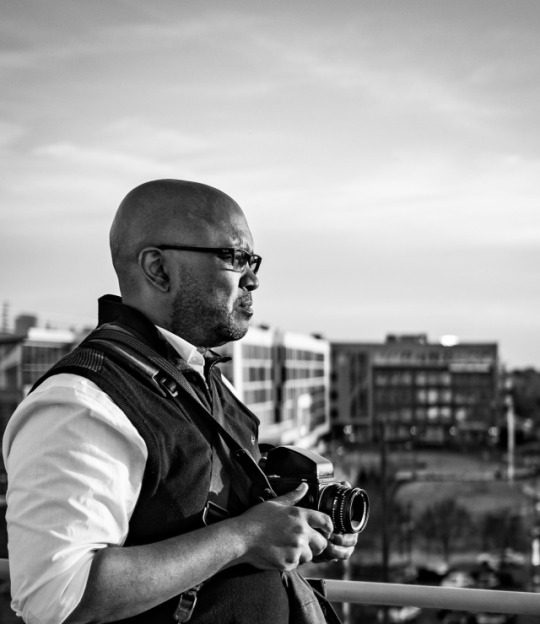
Edde took this with his Leica Q that I tried not to look directly at during the walk for too long. In short, I had a medium format film camera in hand and a bag full of digital gear, while Edde was rolling with one self-contained wonder. Still, I resisted.
Then after some years went by…
A Q showed up at my local camera shop recently.
Dang it.
Took it in hand and told myself not to look at the price on the bottom. I looked. Was initially stunned by, but not really surprised by, the price. Holding its value better than I had hoped.
Went home and looked at the prices of examples online and realized the Q really holds its value. This local example was very much priced to move. If I ever was going to get one this would likely have to be it. Dang it.
Went on to finally read and watch the reviews and deep dive into the specs I had all avoided all of these years. Hope was that these would back me down. Snap me out of it. Sheesh. A rare consensus. Praise after praise. And the specs listed features I did not expect of any all in one camera, especially a Leica.
OIS
Found this particularly surprising. My one real bogey, the RX1, does not have this feature. Digital stabilization does not count. Having long become spoiled with OIS it is now a must-have feature.
Macro
So avoided early reviews and specs that I had no idea that it had a macro function. The party piece is the shifting distance markings. Amazing bit of engineering and design that actually works.
Leaf shutter.
Silent shooting with physical shutter up to 1/2000s and flash sync up to 1/500s. Will not ever likely use flash, but the silent shooting is a definite plus.
E-shutter.
Up to 1/16,000s shutter. What? This means completely silent stills in daylight with the aperture wide open without an ND filter any time I want.
WiFi/NFC.
Well implemented remote control and file transfers by all accounts. I see you Leica.
10fps… 10fps!
3 years old and bests the rightly highly regarded newbie 8 fps A7iii (No ding intended. Love that camera. Just facts.).
AF.
Fast and accurate AF on a full frame Leica. That is a ‘take my money’ sentence.
Direct manual focus.
With assists. WIth hard stops. Focus tab with an ingenious AF/MF switch built in.

Not drive by wire. With zoom and peeking. No. it is not a proper rangefinder, but it more than makes up for it with it’s well thought out and elegant implementation.
Face detect AF.
Another ‘take my money’ feature.
Touch screen with touch focus.
Greatly helps to mitigate the omission of a tilt screen for me.
AF Tracking.
Actually works.
Favorites menu.
Most recent firmware I installed added a favorites menu where you can choose what comes up first. Found the menus already to be intuitive and quick to navigate, but this is even better.
User profiles.
Quickly switch between my favorite self defined configurations (B&W/High Speed/Street/Normal) just like I have set on all of my other cameras.
Video.
Not pro grade. No mic jack. Not 4K. But AF tracking is good and more than serviceable for the few occasions I would want to capture video.
Decided a test drive was in order. Does it add up? Have been disappointed in the past when real life experience does not match the hype and/or spec sheet. Not the case here.
Lower price non Leica comparisons.
Having owned and tried many digital cameras (Sony RX1 line, Fuji X100 line, Ricoh GR line and the like) I can honestly say that this camera is greater than the sum of its parts. It is not about capability since any number of cameras can produce excellent images. But even if you took the word Summilux out of the equation this camera matched or bested every camera listed above ergonomically in my book. I spent near no time staring at the camera wondering how to change setting X or Y. Switch to MF? Move the focus wheel on the lens away from AF. Change the aperture manually? Move the dial on the lens off of A. Change the shutter speed manually? Move top plate mounted shutter dial off of A. Change the ISO? Press button on the back marked ISO and turn the wheel. Hey, what is this unmarked dial on the top do? What do you know it adjusts the exposure compensation. All this in the first few moments after having picked up the camera without ever picking up a manual or visiting Youtube. Your mileage may vary, but add the Summilux name back in on top of that (and my notes below) and it is a no brainer for me.
Higher price Leica comparisons.
Leica M acolytes look away until the next paragraph. Nothing to see here… Seems absurd to say, but at the Qs price point there is value to be had here. To achieve the equivalent Leica M specs of this lens and body combination one would need to spend many thousands more for a digital 24MP M 240 body (new or used) or Summilux lens (any focal length used or 28mm new). And I did say ‘or’ not ‘and’. Combine the two and you easily surpass what I paid for my dadmobile daily driver on up into five digits. Some would say that an M advantage is that you can change the lens. Moot point for me. Truth is that if I ever did buy a comparable M lens and body there would be no budget left ever for another lens. And no AF at that price. Tell me of a less expensive AF true Summilux full frame experience anywhere and I am all ears. Not arguing worth. Stating what I am personally willing to pay.
But both comparisons ultimately miss the point. To say the most cliched of cliched things you have to use it and evaluate the results for it to make sense. Hard to relay in words, but since we are here let me try. Imagine if you combine:
Summilux.
I.E. outstanding sharpness wide open, class leading sharpness stopped down a little, great focus fall off, great contrast, creamy bokeh, and wonderful colors. Best lens I own hands down is permafused to this camera.
Near DSLR speed swift and accurate AF acquisition.
Even in low light. How they did this with contrast detect AF only I have no idea. Some Panasonic partner magic perhaps?
10fps.
With useable AF-C tracking in a pinch. That bests all of my other quite capable interchangeable lens cameras.
Best of the best mirrorless manual focus implementation.
Utterly silent shooting.
Best of any digital I own 1/16,000s shutter speed available.
Not to be used for panning/fast moving objects or it will distort, but fantastic in relatively static brightly lit conditions. 1/2000s leaf shutter available if need be for motion.
24.2MP.
This the goldilocks MP count for me. Any less is not enough of a post crop detail safety net for my liking. Any more eats into archive RAW archival storage space quickly and noticeably impacts the speed of my post processing workflow.
Full frame.
Some of my favorite work ever was done in MFT. APS-C is just fine for most all purposes. But if available I prefer full frame.
OIS.
Mentioned above, but deserves mentioning again.
Time lapse, panorama and other scene modes.
Have not gotten around to using any of this yet. But glad it has them.
Macro.
Mentioning again, because this is not just macro writ large on a non macro lens, but actual fast AF wonderfully implemented real deal macro capabilities.
EVF.
Best EVF I have ever used. And I have used a lot of EVFs.
In body 35mm and 50mm field of view crop.
May seem silly since you can crop after the fact. Made more useful since the images are so sharp that cropping still leaves plenty of detail.
Great for sharing real time with the Leica app. Crop while you shoot instead of after the fact.
If you shoot RAW and JPEG like I do it is the best of both worlds since RAW files are not cropped.
Monochrome JPEGs.
There are other JPEG settings, but this is the only one that matters to me.
Small.
No, not as small as the also full frame RX1 line, but tried it and that camera is too small for my beef mitts. Bought and sold two RX100 cameras for the same reason. For me there is such a thing as too small. A nice size with half case and hood, but remove both and I am able to get this camera into a jacket pocket. Plus more compact than a similar M set up. And far more compact than a similarly spec’d A7III and lens. I believe this may be the most compact brighter than f/2 full frame digital camera and body combination on the market currently.
Summilux, summilux, and in conclusion summilux.
But not so fast. There have to be minuses, right?
Focal length.
This was one potential demerit that concerned me. As I have pointed out ad nauseam my usual go-to prime focal length is 50mm or thereabouts. But in use, the 28mm focal length has not proved to be an issue at all. It has forced me to move in to get the shot sometimes, but this is where the small, silent, and quick nature of this camera pays dividends. So far I have thoroughly enjoyed taking shots while in the fray rather than having to back up and away. Has proven handy with environmental candid shots also. And if I do need to step back the bright aperture, ample MPs, accurate focus, and very sharp lens means that cropping is no issue. I should not have been surprised since two of my favorite all in one film cameras are 28mm.
Lack of weatherproofing.
Would have been nice. But not really an issue for me. Some of my cameras are weatherproofed technically and they all get put away at the first sign of rain regardless.
Saved the most biased, eye roll/cringe inducing, subjective assessment for last.
Fun.
Fun to use. Fun to review the results. A highly technical and very capable contraption that is simple to use for any situation that does not require a superwide or telephoto lens. I have cameras that have high keeper rates. The Q is the rare camera that has a high “wow factor” rate. And the only one I own film or digital with that “wow factor’ that does not have some usability compromise involved.
So much so that I have gone from carrying a gear bag everywhere to just carrying this camera. In fact I have already traded quite a bit of the gear the Q displaces without hesitation to partially fund this acquisition.
But lastly it has been out so long you might mention. True. But I know of no camera released since that tops this camera. Some mentioned a Leica Q 2 one day, but why? In my humble opinion there is little that would improve this camera.
So in case you were still wondering I like it. A lot.
Here are some sample shots below and here is a link to an ongoing gallery.
Happy shooting.
-ELW
The Leica Q 4 years on: An amazing camera still. @leica_camera #leicaq #leica #leicaqtype116 Not sure how to start this write up. There is some hesitancy on my part, but not for the usual reasons.
1 note
·
View note
Photo

1:72 SAAB OAS 41 'Víðarr'; aircraft "23 Grey" of Skaraborgs Flygflottilj F 7, Swedish Air Force; Satenäs AB, 2014 (Whif/kit conversion) by dizzyfugu https://flic.kr/p/pAFA59 +++ DISCLAIMER +++ Nothing you see here is real, even though the conversion or the presented background story might be based historical facts. BEWARE! Some background: The Víðarr (or Vidar, "Wide ruler", a Nordic god among the Æsir associated with vengeance) or officially SAAB OAS 41 is Sweden's first manned aircraft with stealth technology, and the first aircraft of its kind in Europe in operational service. "OAS" is an abbreviation of the aircraft's primary tactical roles: "Osynlig Attack Spaning", "Unseen attack and reconnaissance missions". Much of the OAS 41's technology and elements were developed and tested on unmanned vehicles, namely SAAB's SHARC and FILUR demonstrators. SHARC (Swedish Highly Advanced Research Configuration) was an experimental unmanned aerial vehicle (UAV) built by Saab AB. Since the late 90-ies SAAB had been carrying out preliminary studies about several Unmanned Aerial Vehicles (UAV) concepts but not taking them into flying demonstrators. In 2001 it was decided to start the SHARC Technology Demonstrator (SHARC TD) project. Because of a limited budget and good in-house experiences from flight tests of instrumented sub-scale aircraft, it was decided that the SHARC TD should be in 1:4 scale of the original SHARC design. One of the major goals of the project was to test the airworthiness process for a military UAV or aircraft of similar layout, and this could well be achieved even with sub scaled aircraft. Even the goal of testing a lean development process for demonstrators could be achieved in that way. The SHARC TD project was initiated in 2001 with first flight less than one year later, on February 11th 2002, with the basic version. The more advanced version made its maiden flight on April 9th 2003, less than two years after project start. In September 2003 the SHARC flew a number of missions out of visual range, ranging around 20 km from the control station location. In January 2004 the effort towards the development of the ATOL functionalities was initiated, and led to a successful flight test campaign in August 2004, during which fully autonomous mission were demonstrated, from standstill to standstill. The SHARC system was composed by two flying demonstrators (BS-001 and -002), a GCS and some GSE for engine start and cooling air supply on ground. The SHARC TD is a 60 kg jet-engine driven aircraft. The airframe was manufactured in light-weight composite materials; the airframe weighed only 8 kg (without landing gear). The payload consisted of a forward looking colour video camera. The avionic system (hardware and software) was designed and manufactured by SAAB and is based on Flight Test Instrumentation system COMET 15 used in the Gripen and Viggen fighter a/c. Before the decision to develop an in house avionic system, a market survey was conduced, but no existing system had been fulfilling specifications. Electro-optic fibres, or “fly-by-light”, were used to the actuators in order to minimize the risk for Electro Magnetic Interference. Saab and FMV’s technology demonstrator program FILUR made its first flight in 2006. FILUR’s main objective was to show the tactical importance of stealth technology applied on aerial vehicles, to gain experience and to set a foundation for stealth requirements for future aerial systems and air-surveillance systems. The focus with the FILUR program was on low signature, for both radar and IR-signature. “Static measurements of radar cross section (RCS) made late 2004 showed really good performance and corresponded with calculated data. In flight measurements of stealth performance will be done as a next step”, said Jan Boström FILUR Project Manager, Saab Aerosystems. The technology developed in FILUR would be used for future Saab systems, being UAVs or manned aircraft, which became the OAS 41 which had been under development since 2004. The SAAB OAS 41 made its maiden flight in 2012, and in early 2014 a pre-production batch of five aircraft has been assigned to Skaraborgs Flygflottilj ("Skaraborg Air Force Wing") F 7 in Satenäs, where the aircraft are operated alongside JAS 39 Gripen multi-purpose fighters for evaluation and integration. Conceptually the OAS 41 is very similar to the much earlier US-American F-117, dedicated to ground attacks with precision weapons, attacks against coastal/sea targets and reconnaissance missions. All ordnance or equipment is carried internally in a large bay which is covered by sliding doors. Typical weapons include up to three Rb 75 (AGM-65 Maverick) missiles, two GBU-12 laser-guided smart bombs or two AGM 119 "Penguin" anti-ship missiles. Iron or cluster bombs as well as pods with unguided missiles are also an option. Beyond that, the aircraft can also carry air-to-air missiles like the actice radar RB 99 (AIM-129 AMRAAM) or the IR-guided Rb 74 (AIM-9L Sidewinder), up to four of each. The OAS 41 does not feature an internal gun, even though up to two podded Mauser BK 27 cannons can be carried internally. Overall, its range of weapons is highly identical to what the JAS 39 Gripen can deploy. Alternatively to offensive loads, the OAS 41 can carry camera of sensor pallets in its belly, making it highly adaptable. It is uncertain how many aircraft wil actually be built, since the Swedish Air Force officially announced that the OAS 41 is not to replace its JAS 39 fleet, rather complement it or take over exclusive missions due to its stealth features. The type's limited performance will probably confine to a limited scope of missions, and with the running cost reductions it is not expected that more than 30 OAS 41's will ever leave the production line for the Swedish Air Force, unless it would be exported and follow in the Gripen's footsteps, but this remains doubtful. General characteristics: Crew: 1 Length: 6.70 m (21 ft 11 in) Wingspan: 18,29 m (59 ft 11 in) Height: 3,96 m (13 ft) Wing area: ~68 m² (729 ft²) Empty weight: 6.739 kg (14.844 lb) Internal fuel: 2.500 l Max. takeoff weight: 13.600 kg (29,760 lb) Powerplant: 2× Svenska Flygmotor RM13S turbofans (General Electric CF34-3S), with 4.150 each Performance: Maximum speed: 692 mph (1.115 km/h) at height Cruise speed: Mach 0.7 Landing speed: 210 km/h Range: 4.828 km (3.000 mi) with internal fuel Service ceiling: 13.381 m (43.830 ft) Rate of climb: 60 m/s (11.811 ft/min) Armament: Up to 3.000 kg of ordnance, all carried in a ventral bomb bay, including air-to-ground and air-to-air missile, smart and iron bombs, gun and rocket pods, ECM equipment and pallets with cameras and sensors for reconnaissance missions. The kit and its assembly: This stealth aircraft is basically a scale-o-rama project: it is a Dragon B-2 bomber in 1:200 scale turned into a 1:72 scale aircraft. What sounds easy is more complex than it appears: you need a cockpit with a proper canopy, the landing gear has to be adjusted and there are many small details that need attention. For the cockpit installation I decided to implant a complete X-32 section from a Revell kit, it replaces the complete B-2 spine. It appears a bit bulgy, but upon close inspection of the potential internal layout I found that you can either have a flush canopy OR a bomb bay. Since I wanted to keep the latter (and enlarged it), the cockpit went a bit higher. As a result, the original X-32 canopy looked much to bulbous, it was way too high. Searching through the spares pile I eventually turned up an old F-18B canopy, which, reversed and cut into shape, could be transplanted onto the X-32's cockpit frame, even tough some sculpting at the rear was necessary. Since the F-18 canopy had some glue stains I had to sand and polish it, and as a final coat I decided to apply some light brown translucent paint. Fit is not 100%, though, but it looks good now. The high cockpit necessitated some visual counter-balance at the rear. Originally I had hoped to keep the OAS 41 fin-free, but I eventually dug out a pair of F-117 fins that were cut down in length and glued to the airframe, slightly canted outwards. The landing gear is all new. The massive front strut comes from a F-117, the wheel from the X-32. The front well was enlarged, as good as possible, but it is still too short... don't lokk there closely. ;) The main landing gear struts were taken from the X-32, while the wheels come from the F-117. The wells were lengthened at the rear, so that the longer legs find enough space. The B-2's original bomb bay was cut out and replaced by a completely scratched interior that allows the carriage of a pair of laser-guided bombs, which come from the scrap box. The exhaust slits were modified, too. They were made wider, and inside a kind of ramps were added - the original 1:200 B-2 has nothing inside. For the same reason I also added light blocks, pieces of dark grey foamed plastic, inside of the air intakes and the exhausts. Finally, at the aircraft's front, some pitots were added, but that's all since the overall hull was to remain clean. Painting and markings: I originally had the plan to make this a Japanese aircraft, but then I decided to make it a (kind of) tribute to the innovative Swedish aircraft industry - the SAAB OAS was born, and it was to carry an appropriate, if not odd, paint scheme. Even though "Fields & Meadows", made popular by the Saab 37 Viggen, was an option, I did not want to copy that style. But an angular scheme appeared logical as to confuse the aircraft contours. The splinter paint scheme I eventually settled upon was vaguely inspired by Norwegian "Skjold" class coastal patrol ships, which have stealthy hulls and carry a three-colored spinter scheme in grey, sand and dark brown. Odd for a ship, one might say, but in front of the typical Norwegian rocky coastline, it is highly effective, and even on the open sea, viewed from above, it is not a bad scheme at all. The pattern was vaguely lent from the Skjold boats, and I used different tones which would IMHO be more versatile: a reddish brown (WWII French Earth Brown), Field Grey and Olive Drab, in a wraparound scheme. Together with the edgy shape of the aircraft this turned out to be pretty effective - a bit of a surprise! The rest was rather straightforward: white for the air intakes and the landing gear, the cockpit and the bomb bay were painted in Neutral Grey. The pair of internal GBU-12s was painted in light grey, a typical tone for such weapons in Swedish use witn the JAS 39 Gripen. The kit received a light black ink washing and some panel painting with lighter shades of the basic tone, just to amphasize contours and simulate some structure and acccess panels esp. in the engine area. After decal application (puzzled together, among others, from an Italeri JAS 39 Gripen) the kit was sealed with Revell's matt acrylic varnish. In the end, a rather simple whif - I am not a friend of stealth aircraft, since they are IMHO boring. The splinter scheme changes this a bit, and the high cockpit does not look that bad at all, even though the original X-32 canopy looked REALLY weird.
3 notes
·
View notes
Text
It’s Easy to See Ceres, the Full Strawberry Moon meets Mars after Saturn, and the Ringed Planet Peaks for 2018!

(Above: On Wednesday, June 27, Saturn reaches its closest and brightest point for this year. That same night, the full moon will sit just above it. Many spectacular deep sky objects sit around Saturn, and are better seen once the moon moves away. Look for the large, bright open cluster designated M24 sitting above Saturn all summer.)
Astronomy Skylights for this week (from June 24th, 2018) by Chris Vaughan. (Feel free to pass this along to friends and send me your comments, questions, and suggested topics.) I post these with photos at http://astrogeoguy.tumblr.com/ where the old editions are archived. You can also follow me on Twitter as @astrogeoguy! Unless otherwise noted, all times are Eastern Time. Please click this MailChimp link to subscribe to these emails. If you are a teacher or group leader interested joining me on a guided field trip to York University’s Allan I. Carswell Observatory, or another in your area, visit www.astrogeo.ca.
If you’d like me to bring my Digital Starlab inflatable planetarium to your school or other daytime or evening event, visit DiscoveryPlanetarium.com and request me. We’ll tour the Universe together!
Public Events
On Monday evenings, York University’s Allan I. Carswell Observatory runs an online star party - broadcasting views from four telescopes/cameras, answering viewer questions, and taking requests! Details are here. On Wednesday evenings after dark, they offer free public viewing through their telescopes. If it’s cloudy, the astronomers give tours and presentations. Details are here.
On Friday, June 29, starting at 7 pm, the U of T AstroTour will present their planetarium show entitled Grand Tour of the Cosmos. Tickets and details are here.
The next RASC Family Night at the David Dunlap Observatory will be on Saturday, July 7. There will be sky tours in the Skylab planetarium room, space crafts, a tour of the giant 74” telescope, and viewing through lawn telescopes (weather permitting). The doors will open at 8:30 pm for a 9 pm start. Attendance is by tickets only, available here. If you are a RASC member and wish to help us at DDO in the future, please fill out the volunteer questionnaire here. And to join RASC, visit this page.
The Moon and Planets
To begin this week, the moon will be shining brightly in the evening sky as a nearly full (waxing gibbous) globe. Remember to pull out your binoculars or small telescope and look along the boundary separating the lit and dark sides. That’s where the most dramatic moonscapes are. Because the moon reaches its full phase on Thursday at 12:53 am EDT, the moon will look full on Wednesday evening and slightly past full on Thursday night.

(Above: The full Strawberry moon is nick-named for the bounty of Mother Nature in June annually.)
The June full moon, colloquially known as the Strawberry Moon, Mead Moon, Rose Moon, or Hot Moon, always shines in or near the stars of southern Ophiuchus (the Serpent-Bearer). Because the moon reaches full when it is opposite the sun in the sky, full moons always rise in the east as the sun sets, and set in the west at sunrise. Since vertically impinging sunlight casts no shadows on a full moon, all of the surface brightness variations are generated by differences in the reflectivity, or albedo, of the lunar surface rocks.
In the southeastern sky after dusk on the Wednesday evening, the full moon will sit one finger’s width above bright, yellowish Saturn. The two objects will cross the sky together during the night and will easily fit within the field of a small telescope at low magnification. Meanwhile, the moon’s separation from Saturn will noticeably increase as the moon slides eastward in its orbit during the night.
The large open star cluster called Messier 24 will sit a few finger widths above (to the northeast of) the moon and Saturn. The cluster, also known as the Small Sagittarius Star Cloud, is three times wider than the moon! Try to see it using binoculars, or wait for the moon to move away on the following nights and use Saturn to find it then.
After mid-week, the moon will slide east, rise later, and begin to wane – with the dark region growing on the moon’s western (our right-hand) side. About 11 pm local time on Saturday night, bright red Mars will rise in the east with the waning gibbous moon shining 4 finger widths to the upper left (northeast) of it. Both objects will fit into the field of view of binoculars. By dawn, the pair will appear low in the southwestern sky.

(Above: The inner planets Mercury and Venus continue to put on a good show this week, as shown here for 9:30 pm local time on Sunday, June 24. Mercury will fade and descend next week, while Venus will continue to brighten.)
Venus continues to catch our eye in the western evening sky this week while it continues to swing away from the sun - and it will still get brighter! The planet will be setting at about 11:30 pm local time all week because it is travelling east while the entire sky is shifting west, holding it in place. Venus is gradually growing larger as it moves towards Earth. In a small telescope, the planet’s disk will not look round. Instead, it will exhibit a gibbous (70% illuminated) phase.
This is the best week to see elusive Mercury sitting low over the northwestern horizon for a brief period after sunset. It recently peaked in brightness and the best time to look is between 9:45 and 10:15 pm local time. You’ll need a low open horizon because the planet will be only a few finger widths above the horizon (or less).
Jupiter is the bright object you will see shining brightly in the southern sky after dusk this week. Around that time, it will be at its highest elevation (about three fist diameters) above the southern horizon. Over the following five hours, it will move west and descend – setting in the west-southwest about 3 am local time. Once it’s dark enough, look for a bright star sitting just to the lower left of Jupiter. That’s Zubenelgenubi, the brightest star in Libra (the Scales). In binoculars or a small telescope, it splits into a closely separated pair of stars.

(Above: On Monday, June 25, the shadow of Jupiter’s moon Ganymede will transit the northern zone of the planet, along with the Great Red Spot, as simulated here at 10 pm EDT.)
On Monday, June 25, and visible between 9 pm (in twilight) and 10:42 pm EDT, the little, round, black shadow of Jupiter’s moon Ganymede will cross (or transit) near the north pole of Jupiter’s disk. On Saturday, June 30 starting at 1:14 am and visible until Jupiter sets, the shadow of Jupiter’s moon Io will transit. A reasonable backyard telescope will show the black shadows, but a very good telescope is needed to see the moons themselves. More shadow transits are available in other time zones around the world.
The Great Red Spot (or GRS, for short) takes about three hours to cross Jupiter’s disk. But the planet’s 10-hour rotation period (i.e., its day) means that the spot is only observable from Earth every 2-3 nights. If you’d like to see the GRS, use a medium-sized telescope (or larger). You’ll have your best luck on evenings with steady air – when the stars are not twinkling too much. The best times to try this week are: Monday, June 25 at 1:18 am and again at 9:09 pm (in twilight, with a Ganymede shadow bonus), Wednesday, June 27 at 10:48 pm, and Saturday, June 30 at 12:27 am. All times are given in Eastern Daylight Time (EDT), so adjust for your local time zone. Try to look within an hour before or after the times I’ve given.

(Above: Look for Saturn above the Teapot-shape of Sagittarius all summer. On opposition night, June 27, the full moon will join the party, as shown here at 11 pm local time.)
On Wednesday, the Earth’s orbit will carry us between Saturn and the sun. Sitting opposite the sun in the sky (a term that astronomers call opposition), Saturn will be visible all night long, and the planet’s disk will be the brightest and largest (18 arc-seconds) for the year. Planets don’t emit their own light. We see them because the sun’s light has travelled all the way out to them and reflected off their surfaces. At opposition, the reflected light from Saturn will travel for 75 minutes to reach Earth – and our human eyes.
Yellow-tinted Saturn will rise in the southeastern sky at about 9 pm local time this week, just as the sun sets. The ringed planet will be spending the summer of 2018 just to the left of the Milky Way, and just above the Teapot-shaped stars that form Sagittarius (the Archer). Saturn moves over the southern horizon, its highest point in the sky at 1:30 am local time. It will remain visible until about 5 am local time, when it will sit more than a fist’s width above the southwestern horizon. Scientists have recently determined that Saturn’s reflective icy rings formed only a few hundred million years ago – during Earth’s Carboniferous Period, when early dinosaurs roamed our planet!

(Above: Mars rises well after Saturn, but still before midnight, as shown here on June 27 at 11 pm local time.)
Mars is getting good now! The Red Planet will be rising in the east just after 11 pm local time this week. Mars will continue to steadily brighten and increase in apparent size (when viewed through a telescope) as the Earth’s faster orbit brings us closer to the red planet until July 31. Mars will reach its highest position, over the southern horizon, around 3:30 am local time, and then remain visible until just after 5 am.
Distant blue Neptune, among the modest stars of Aquarius (the Water-bearer), is observable in telescopes in the eastern sky after it rises around 13:30 am local time. This week, look for the magnitude 7.9 planet sitting one finger width to the right of the naked eye star Phi (φ) Aquarii and about five finger widths to the left of brighter Hydor (Lambda Aquarii).
Blue-green coloured Uranus is visible in binoculars, if you know where to look. It, too, is in the eastern pre-dawn sky, located about four finger widths to the left of the modestly bright star Torcular, which is down toward the “V” where the two cords of Pisces (the Fishes) meet. I posted sky charts for Uranus and Neptune here.
It’s Easy to See Asteroids - Sometimes
Here’s a very easy way to see an asteroid with your own eyes. After dusk on the evening of Wednesday, June 27, the large dwarf planet (formerly asteroid) Ceres will sit only 9 arc-minutes (or less than one third of the moon’s apparent diameter) above the bright, visible double star Algieba in Leo (the Lion). Algieba marks the throat of the lion, midway along the backwards question-mark that forms the front of the constellation. After dusk, the lion will be positioned over the western horizon and tipped with his face downward to the right. I’ll post a sky chart here.

(Above: Thursday, June 27 brings the perfect chance to see the dwarf planet Ceres when it passes very closely above the naked-eye double star Algieba in Leo the lion. Use binoculars and small telescopes on the double star and look for a small object just above it. The sky is shown for 10:30 pm local time.)
Use binoculars to look for Ceres as a little, star-like object just a short distance above Algieba. A small telescope at medium-high magnification will show Ceres and Algieba’s close-together pair of distant stars together in the same field of view.

(Above: A detailed view of the region around Algieba and Ceres on June 27. The yellow circle represents the field of view of a medium power telescope.)
After a determined search by many astronomers who were looking for a theorized missing planet, Ceres was the first asteroid ever discovered, by Giuseppe Piazzi in Palermo, Sicily, on January 1, 1801. It was named after the Roman Goddess of Agriculture. (The same name gave us the word “cereal”!) Ceres was originally given planet status, orbiting as it does between Mars and Jupiter. But calculations of its 950 km diameter, and later discoveries of countless additional bodies in the asteroid belt, led to its demotion to queen of the asteroid belt. But in 2006, the same rules that demoted Pluto to dwarf planet status promoted Ceres to the same class of objects. Good luck!

(Above: The path of the large asteroid Vesta (red line) over the month surrounding June 19, when it reached peak brightness, within range of binoculars. The sky is shown at 10:30 pm local time.)
As I mentioned last week, another asteroid, the minor planet (4) Vesta, is now visible all night long, and appearing about its brightest (magnitude 5.33) for the year - within reach of binoculars and small telescopes. Look for the object above the Teapot-shaped constellation Sagittarius (the Archer), about a fist’s diameter to the upper right of Saturn.
Keep looking up to enjoy the sky! I love getting questions so, if you have any, send me a note.
#astronomy#planets#stars#Saturn#Vesta#Ceres#Venus#Jupiter#the great red spot#universe#stargazing#full moon
2 notes
·
View notes
Text
Sunday Mysteries: The hunt is still on for BIGFOOT
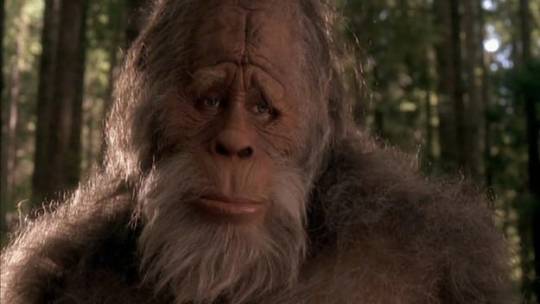
Is Bigfoot Real? What made the oversized tracks found in Bluff Creek, California, and other parts of America? A giant ape or just a big jape? In 1924, a group of miners working in the Cascade Mountain Range in the state of Washington were startled to see a huge simian creature staring at them from behind a tree. Panic-stricken, one of the men fired at it and although the bullet appeared to hit the giant ape in the head, the beast ran off, apparently unharmed. Soon afterwards another of the miners, Fred Beck, spotted it again on the edge of a canyon and again fired, this time hitting the creature in the back. The group watched as it fell over the ridge. They scrambled at once down into the canyon below, but could find no trace of the creature’s body. However, that evening as it grew dark, the men heard strange scratching noises outside their log cabin and saw shadowy gorilla-like faces at the window. The terrified miners barricaded the door but soon the creatures were hammering at the roof and walls. Heavy rocks were thrown and the cabin rocked from side to side. The men began shooting through the walls in all directions but still the hammering continued, only ending as the sun rose the next morning. The miners packed up at once and left the cabin, vowing never to return. It was only after Eric Shipton famously photographed a giant footprint on the Menlung Glacier of Mount Everest in 1951, putting his pickaxe alongside to show its size, that interest in giant apes began to gather pace. During the 1953 expedition to Everest, when Edmund Hillary and Sherpa Tensing were the first to successfully climb the mountain, both men reported seeing oversized footprints. Although Hillary later disputed that these were yeti tracks, there was so much interest in finding out more that the Daily Mail sponsored a ‘Snowman’ expedition in the Himalayas the following year. Keen to discover more about America’s very own yeti-style legend, John Green tracked down Fred Beck in the late 1960s and interviewed him for his book On the Track of the Sasquatch, and the Bigfoot mystery took even firmer root in America. The word ‘Sasquatch’, applied to the large, hairy hominid in its North American manifestation, was first coined much earlier – in the 1920s – by J. W. Burns. While working as a schoolteacher at the Chehalis Indian Reserve on the Harrison River, he had learned that Native American Indians used the words soos-q’tal and sokqueatl to describe the various ‘giant men’ of their legends. To simplify matters, Burns decided to invent one name to cover all such creatures, and through one of his articles – ‘Introducing British Columbia’s Hairy Giants’, published in MacLean’s Magazine in 1929 – ‘Sasquatch’ passed into wider use. As the public fascination for the giant apeman grew, the media began to report sightings on a regular basis. In 1958 road construction worker Ray Wallace was amazed when his colleague reported finding huge footprints in the dirt at Bluff Creak in northern California, the area they were working in. The local press descended and soon the story was front-page news all over America. Casts were made of the prints, which experts declared genuine. The first newspaper to carry the story, the Humboldt Times of Eureka in California, used the name ‘Bigfoot’ in their headline, and the word has since become synonymous with America’s favourite mystery creature. When more tracks were found, Sasquatch hunters flocked into the now famous Bluff Creek area to see what else they could discover. It wasn’t until Ray Wallace’s death, in December 2002, that the mystery was revealed. Members of Ray’s family requested that his obituary should announce that, with his passing, Bigfoot had also died. Ray Wallace immediately became one of the most controversial characters in Bigfoot history when it was revealed that he (along with a handful of his close friends and co-workers) had made the tracks. Investigators soon found out that all of the tracks appeared in areas Ray had worked in. In the early days that had been in Washington State, where the first footprints had been found, while over twenty years later discoveries were being made further south, in California. Bigfoot had not been on the move, Ray Wallace had. Family members produced dozens of different oversized foot moulds made out of wood or clay that Ray would have spent weeks crafting and honing. His buddies, by then rather elderly pranksters, showed in television documentaries how they had created the vast footsteps: holding on to a rope tied to the back of a logger’s truck being driven very slowly had enabled them to take the giant steps that had so fooled expert analysis. In much the same way as crop-circle makers simply enjoy confounding the experts, so did Ray and his pals. However, despite The New York Times running the news as a headline story, many Bigfoot researchers have discounted the revelation (not altogether surprising – cynics might say – when their credibility was on the line) and even tried to discredit the Wallace family, threatening them with legal action. One poor haunted soul who spent his adult life in search of Bigfoot evidence wondered why anybody would put so much time into ‘messing with people’s heads’. The answer, of course, is because it is fun. Fun, and surprisingly easy. Nonetheless, a number of scientists and leading members of the Bigfoot Field Research Centre (BFRC) are, instead, stating that the footprint moulds produced by the pranksters are themselves the fake, not the tracks. In a bizarre piece of reverse logic, some are insisting the Wallace family must prove their claims. John Green, described as one of America’s foremost Bigfoot researchers, loftily remarked of Wallace that if he had revealed the footprint mould during his lifetime he ‘would, of course, called upon to prove himself’. I am unable to see how anybody can become a ‘foremost researcher’ when they have discovered exactly the same amount of genuine evidence of Bigfoot as I have – that is, absolutely nothing. It was, after all, John Green who interviewed Albert Ostman in 1957 and fell for his tall (in more senses than one) story. Ostman said he had been looking for gold in British Columbia during the gold rush of 1927, when he had been kidnapped by an adult male Sasquatch. The beast gathered up the man in his sleeping bag and carried him several miles. He was then dumped on the ground and realized, shortly afterwards, that he was being held by a family of four who would not let him leave their camp. After six days of captivity, he concluded he was being considered as future husband material for the young female, so he fired his rifle into the air, distracting the family for long enough to make his escape. When Green asked why Albert had not told his story before, the ageing gold prospector replied that he thought nobody would have believed him. And few did, except John Green and his vast fan base of Bigfoot believers ready to leap to his defence on every issue. But Green did finally concede, in 2007, that he ‘would not believe the story if he were told it today’. Take another established piece of ‘proof’ – the footage of a female Sasquatch filmed by Roger Patterson in Bluff Creek. The story goes that in October 1967 Patterson and his friend Bob Gimlin were riding through the creek when their horses reared up and they were both thrown to the ground. Extract from Mysterious World As they picked themselves up, they noticed a ‘huge, hairy creature walking like a man’ about thirty yards ahead of them. Patterson grabbed his cine-camera and began filming the beast as she loped away, pausing only once – and looking directly into the camera lens as she did so – before disappearing from view. The film has become world famous and has been studied by zoologists, crypto-zoologists, palaeontologists, biologists, anthropologists, archaeologists, Uncle Tom Cobbley and all. And you will be unsurprised to hear that opinion is divided about whether it is genuine footage (Bigfootage?) or not. Leading scientists did, however, conclude at the time that there was ‘nothing in the film that leads them, on scientific grounds, to suspect a hoax’. Having now made my own detailed study of the film, using ultra-slow, frame-by-frame-pausing technology obligingly provided by Sony (namely, the DVD player in my front room), I can now add to the debate. To my albeit untrained eye, the creature looks suspiciously like a man in a monkey suit on his way to a fancy-dress party.
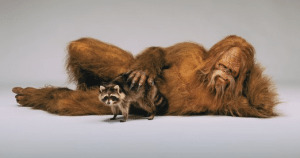
Seasoned Bigfoot researchers nevertheless regard the film as a significant piece of evidence, saying that to suggest that it was a hoax would be ‘demonstrably false’ – that old double-negative rhetoric again. But even non-researchers, including the physical anthropologist Grover Kranz, confirm the film does depict a ‘genuine unknown creature’. Another prominent primate expert, John Napier, is still not entirely convinced but once revealed: ‘I could not see the zipper then and I still can’t. Perhaps it was a man dressed up in a monkey costume; if so it was a brilliantly executed hoax and the unknown perpetrator will take his place with the great hoaxers of the world.’ So does this mean if he can’t see the zip, it can’t be a monkey suit? Or had the hoaxer compounded his/her cleverness by inventing an early form of Velcro? In 2004, Greg Long revealed in his book The Making of Bigfoot that the grainy clip was in fact an elaborate hoax. Long claims he had managed to trace the monkey suit to costume maker Philip Morris, a gorilla suit specialist from North Carolina. In the book, Morris states he sold the suit to Roger Patterson for $435, and when he saw the Bigfoot photos on the television and in the newspapers a few weeks later, he recognized the suit as the one he had made. Morris claims never to have revealed this information before because to break ‘client confidentiality’ in such a public manner would have lost him customers. It might have saved millions of research dollars, though. Greg Long revealed the man in the suit as Bob Heironimus – a friend of Patterson’s – who subsequently told the Washington Post: ‘It’s time people knew it was a hoax. It is time to let this thing go … I have been burdened with this for thirty-six years, seeing the film-clip on television numerous times. Somebody’s making lots of money out of this, except for me. But that is not the issue, the issue is that it is finally time to let people know the truth.’ John Green, of course, immediately went on the offensive, calling him a liar and declaring Greg Long had made ‘a fool of himself’. And while Heironimus was a known associate of Patterson and has passed two lie detector tests and Greg Long has found several independent, but supporting, witnesses, John Green still has yet to provide a single piece of evidence for his case that the film is of a genuine, if as yet unidentified, hairy giant. Step forward, then, Roger Patterson himself. Unfortunately, he can no longer be called upon as he died in 1972. However, the other witness to the Bigfoot sighting, Bob Gimlin, is still alive. Bob no longer speaks personally about the film as he is ‘fed up with the whole Bigfoot thing’, but his solicitor, Tom Malone, issued a statement to the Washington Post in response to their story about Heironimus’s revelation: ‘I am authorized to tell you that nobody wore a gorilla suit or monkey suit and that Mr Gimlin’s position is that it’s absolutely false and untrue.’ Which seems clear enough, but it is quite possible Gimlin didn’t know about Patterson’s hoax and was simply used to increase its credibility. Even if he was in on the act, Gimlin has always maintained the film to be genuine and so any revelation now, forty years after the event, would be somewhat embarrassing for him. In 1969, another set of tracks was reported – in Bossburg, Washington – that, on closer inspection, revealed the giant beast’s right paw was in fact club-footed. Experts argued that this indicated that the tracks were very likely to be the first genuine piece of evidence to support the existence of the Sasquatch. Professor John Napier, whose book Bigfoot was published in 1973, wrote: ‘It is difficult to conceive of a hoaxer so subtle, so knowledgeable – and so sick – who would deliberately fake a footprint of this nature. I suppose it is possible but so unlikely I am prepared to discount the idea it is a hoax.’ Straight from the school of ‘If I couldn’t think of it then nor could anybody else’, and with such imaginative minds on the trail of Bigfoot, it is hardly surprising he has managed to elude us for so long. Despite sightings of Bigfoot reported in every American state except Hawaii and Rhode Island, the creature’s natural habitat is said to be the remote woodlands and forests in the Pacific Northwest of America and Canada. The Rocky Mountains have provided many sightings, as have the Great Lakes. But if this is the case, how could he have got to Florida, California and other southern states? The Sasquatch would have had to leave the cover of his remote woodland hideaway, and it is difficult to imagine how such a creature could travel so far without leaving behind at least some credible evidence. You would certainly spot him in the Greyhound bus queue. But, unfortunately for the wonderfully named Texas Bigfoot Research Center (TBRC), it turns out that most of the evidence found, such as blood or hair samples, footprint casts or photographs, usually turn out to be fake and never, as yet, from an unknown creature. Investigators at TBRC say they receive reports of over one hundred sightings each year in Texas alone, while on the homepage of their website Janet Bord states: ‘If the skeptics are right and there is no such creature as Bigfoot, then it is a fact that thousands of Americans and Canadians are either prone to hallucinations, or are compulsive liars or unable to recognize bears, deer and vagrants.’ Quite how tramps became involved is anybody’s guess. Also on the homepage of the TBRC website is something that bears further examination. One Rick Noll is quoted, stating his reasons why no firm evidence for the existence of a big, hairy, part-man, part-simian-type monster has been found: - No one is spending enough time in the woods, - Not many people know what to do in searching, overlooking things, or vice-versa, seeing things that aren’t significant to the task, - There are not many of these animals around, - They, like most animals in the forest, know how to camouflage themselves quickly and easily, - Most encounters with humans are probably mistakes on the part of the Bigfoot, yet researchers are trying to fill in the picture with them as to being something significant. So there you have it. Those are the reasons the TBRC claim there is, to date, still no credible evidence of the existence of Bigfoot. So how is it then that, despite the use of the whole spectrum of technology – from heat-seeking cameras with night vision to thermal imaging – nobody has confirmed the existence of Bigfoot? Bigfoot enthusiasts apart, the group of people keenest to obtain as much information as possible of the apeman’s existence would be the US government. And as they have surveillance equipment that can detect a small nuclear warhead buried in the desert somewhere near Baghdad, it is fair to assume they would have picked up one of the thousands of Sasquatch that have to exist if all the Americans and Canadians who claim sightings are not lying. Such a large number of sightings does suggest that Bigfoot, or a relative of his, could well be out there; indeed I, like Janet Bord, refuse to believe that so many people can be lying. But hundreds of small, circumstantial and improvable reports do not add up to a single, solid fact. It is like pouring thirty separate measures of Jack Daniels into a large glass. Added together they do not make the drink any stronger in flavour; it still tastes exactly the same. But if you drink it all – as I have discovered through experimentation for this very investigation on your behalf – you will fall over. Scientifically speaking, weak evidence should not become any stronger just because there is lots of it, although it can affect your judgement in the end. But the Texas Bigfoot Research Center is not the only organization dedicated to finding firm evidence: there are many others throughout America. On 27 December 2003, for example, the Pennsylvania Bigfoot Society (PBS) hosted their fifth annual East Coast Bigfoot Conference (ECBC), and the keynote speaker, Stan Gordon, veteran researcher and the founder/director of the Pennsylvania Association for the Study of the Unexplained (PASU), concluded his opening speech linking Bigfoot sightings with known UFO activity in the same areas – although he stopped short of announcing: ‘Bigfoot is a spaceman.’ Which I would have done, just for the headline. leave in ‘There is no doubt the evidence suggests there is something out there,’ he assured the audience, as they sat there hanging on his every word, then continued: ‘We just don’t know what it is.’
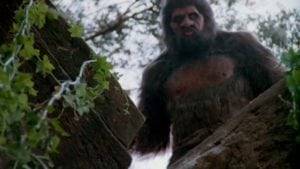
Another speaker at the conference, Paul Johnson, a chemistry professor at Duquense University in Pittsburgh, thought he knew: ‘Bigfoot is a quantum animal that moves freely between the real world as we know it and a quantum world outside the reach of conventional laws.’ He went on to explain how that, in quantum physics, electrons do not follow the normal rules of physics. Although he admitted his ideas were unconventional, he also noted (contradicting himself in the process) that nothing as large as Bigfoot could behave like an electron in reality, which was a relief because everybody knows that a living being is unable to dematerialize and then reappear in perfect working order in another place. Unless, of course, you are travelling on the starship Enterprise,and then you can. Another speaker at the ECBC, Janice Coy from Monroe County, Tennessee, claimed her family had developed a relationship with a family of Bigfoot (or should that be ‘Bigfeet’?) since 1947. Her grandfather, having stumbled across an injured Bigfoot, had bandaged its broken leg and allowed it to recover in a barn at the family farm. She claims to have even held a baby Bigfoot in her arms and explained that for years she had tried to obtain photographic evidence, without success. She picked up on Paul Johnson’s quantum theory and suggested that was the reason none of her photographs ever returned to her with images any clearer than a ‘shapeless fuzz’. And no one likes to see a shapeless fuzz now, do they. On one occasion the Sasquatch family, realizing the camera was present on a nearby tripod, used long sticks to retrieve food from a place out of range of the lens. On another occasion, the roll of film Janice submitted to a commercial processing lab returned to her after the film had been mysteriously overexposed, and every image lost for ever. Read the full article
0 notes
Text
The Coward Adventurer
"I think I'm slowly growing a mustache that will conduct a transvestite orchestra."
I looked at him briefly during the downwards arc of my glance, "well thats good", and I meant it sincerely, "because someones gotta do it. This bastard over here", I gestured towards the other room and through the doorway, "he's got slugs for days but wont grow the balls to commit."
He sat with his bass guitar, teeth clenched, managing a few acronyms "Ehh?" like a frantic centipede on his last legs, disregarding it all to return to some strange form of science.
"No matter", I said, redirecting my attention towards the maniac trying to sleep at my feet, "I think you should cool your guns. It happens, it happens. You can't expect something to happen if it hasn't happened before. Right?"
In the beginning I was approached by Dynastic Industries to commission a musical piece based on the time I spent in Indonesia. I was there initially to do some work for a successful blog I was a part of called Why Where and What the Fuck. And why the fuck D.I. approached me or chose to employ me in any way or for any reason at all still bewilders me.
WWWF had initially hired me as a writer when they caught me on camera during a Turkish uprising kind of thing in Berlin dressed up as an Osama Bin Laden clown character and giving away free condoms to all the turkish children, or at least I told WWWF that this was my agenda and since then i've sort of become their mozart genius marionette. Letting them pay for me to travel around and be kind of an idiot in the process.
And one time they sent me to Indonesia. I had this guide named Yusef. Yusef loved everything I did but all I really did was just get drunk the entire time I was there. I think I managed some scribbles on the backs of other people's suicide notes or maybe I had etched a few artistically interpreted Sumarian glyphs on random pieces of pottery, maybe a few pages of notebooks here and there. But certainly not anything at all to write home about; Like literally no writing got home at all. It wasn't even Youtubed. They wrote the entire article from translations of the Yusef's journal. I mean, Interpreting his dialect into a palpable demonstration of my experiences from the view point of a native who was also insane and spent most of our time sitting around trees while he wrote about eternal chaos and the derivatives of perspective in that goddamn journal is great but it may or may not say anything about what I was actually experiencing.
The whole time its just me, staring at him, wondering why I cant write a word. (….) I now realize its because I was watching myself write and there was nothing to add. By being obsessively observational, I had become my own guide in my own right. And I guess it panned out...
Or maybe it didn't. At this point I am completely unsure.
For example: I don't have a lot of standards for living and still there are things now that are capable of disrupting what I have always thought to be eternal. Because of the situation I have currently found myself in, I no longer feel as if I have a subtle and well conceived balance and I feel as if I have become a monster in trying to achieve such a thing even though I know it's already there and it's something that had been in front of me my entire life. And here It's like I am constantly trying to balance the finite with the infinite and in the end all I am is shit and that's what I see. It is what you become. White drapes on white sheets with dirty boot scuffs on the trim and dirty oatmeal floors and moldy shower curtains, but everything set to a standard you have set either way. And peoples' minds, constantly enforcing, even if they are rudimentary. Especially so. I had to say fuck it all or become it all. To me it really has not or has ever made a difference at all which way I lean. But of course this is my fault, and because of this perhaps I am a mutant, the holder of the all seeing hand, detached, and it's beckoning the circus freak inside to be let loose, and yet, to live this way is not out of pride or conviction, necessity or convenience and, quite possibly, not even out of lack of trying. But because it is my basic human stigmatic function to build a home and relish in its 'my-ness' whether its a shopping cart or a castle. I have no choice. I am driven to order and none of us can escape it. Even the most avant-garde lifestyle is a victim. Its a 12 tone composition gone wrong, or right, it no longer matters for there is always a boundary.
We were passing through the sewers. Gulping sounds stuck out like we were being sucked into some undercurrent. We came across a television stuck in the wall. It was the "Old Last Time Agenda Variety Show" and there was Razputin, the social phenomenon that was just recently resurfacing from a long term hibernation and public disappearance, his face always recognizable. He stood with his guitar and legendary mustache, the orchestra moving with each flowing twitch. As the bouncy music continues, the camera widened to show his famous and, although now sagging a bit, voluptuous breasts . The dance number began and 2 women and a man appeared, they linked arms with Raz himself and tapped around each other to swaying rhythms and choreography patterns, like drunken swans. The music began to swell and Razputin began to open chambers of his body like cupboards in german kitchen. Hands appeared out of nowhere to reveal his various implants and gender surgery. He revealed his cock, which was filleted into two pieces and inverted, exposed from the inside out. He flicked it like a guitar string and smiled ferociously. His mustache was now two huge, stretching arms. Another drawer revealed what seemed to be his intestines. His face became nontransparent and the music kept bouncing along. He reached down and plucked his bloody coils like a harp, ruffing them up as if to break the strings and find some kind of new tonality, as if to say that none of this mattered, his martyrdom, strange that it was so accepted, but we all knew that this was big.
"Man, this will probably be on the news."
"Yeah of course it will. This is huge."
He kept going at it like some kind of sexual torture, throwing his organs around inside of what was left of himself and still maintaining that maniacal grin. The other dancers began to force him out, concerned with the drunken patterns that he was disrupting. But he kept on, his body now three times wider, revealing parts of himself that could not be contained.
Eventually he was forced off stage and everyone cheered. I remember thinking that this was not something to take lightly as the dancers bowed and accolades were distributed. This was not some typical piece of choreography to briefly consider and then forget.
The haunting voices of the dead appeared again.
"Lets go," someone seemed to have said, and we were off, our feet like popcorn in a mushroom patch.
Things stuck out to us then like blue flowers in a field of wilted dandelions. Our senses were too abrupt. We had found a church.
Like ruins.
0 notes
Photo

Epochal Territories Shoot #2 - 2/12/2020
It didn’t take me long to go back to shooting film. As much as I like shooting digitally, the instant results and high quality, there is something about film which I cannot keep my hands off of. The ability to create physical, analogue images with a cameras the same size as a DSLR, yet create massively higher quality photographs is immensely attractive and alluring.
In addition to this, a camera I have become addicted to is the Mamiya 7ii, which I shot the entirety of Mileage May Vary with. The 7ii is small, light, shoots a massive 6x7 negative and the lenses are incredibly sharp, almost clinically sharp. This might be a deterrent to some, but personally I enjoy across the frame sharpness and detail.
The film is also a massive part of the sharpness of the image, as well as the glass. Developing 120 film is a sour point for me and always triggers my short temper. It is incredibly fiddly and every time I have done it, it has failed miserably. If only there was a simple solution to shoot B&W but not have to develop it oneself - Ilford XP2 Super. This film is a C-41 process B&W film, meaning it can be developed at any photo lab which processes C-41 colour film. XP2 Super isn’t often used by many, but by those who want a simple way to get B&W images without having to buy any chemicals and either develop film at home or find a specialist lab. But it should be regarded higher, as it is a splendid film, which has the added benefits of C-41 colour films such a dynamic range and enjoying some overexposure.

I decided to take a walk, without any aim to where I was going. I started by walking towards Exeter Street, with this image taken on the Tothill Bridge, overlooking the trainline which used to lead to Friary Station, which was demolished in 1976 and passenger services stopping in 1958. I used to live along this line on Desborough Road, and all to often was woken up by British Rail Class 08 or ‘Gronk’ pulling freight up and down the line. Where Friary Station used to stand is now the Friary Retail Park and Friary Court - all bearing the same name as the old railway station.

I progressed with my walk and ended on walking on Embankment Road, which in itself is an odd street that reminds me of a South London street with ancient looking green grocers and out of place shops. On one of the corners is this depilated Volkswagen Passat estate, which with a cursory look at Street View has been parked there since at least 2009, with the Passat gradually becoming worse and worse condition as the years go on. The more urban areas contain more alienation than the rural, where it is a lot more nuanced.

Treeby Court is an strange landscape of concrete and rubble, often used for amusement fairs and travellers. As far as I can remember, it has been empty for years and hasn’t contained anything more than the aforementioned fairs and travellers. It is an incredibly wasted area of space, which could be used for some good, and as far as I can imagine would be rather pricey. In the background is Saltram House, which is where I eventually headed to.

On the outskirts of Saltram House is the more industrial areas of Plymstock. This whole area is inherently alienating, because there is such a lovely landscape with industrial estates, recycling centres and traveller sites nestled within it. The pylon is the centre point of the photograph, taken on a bridge to get a higher vantage point to make the cars and buildings below seem smaller. Within this area is a gas works company, as well as Stagecoach South West, with Chelson Meadow situated next door.

The road leading to Chelson Meadow is called The Ride, which now features a wealth of new houses and estates, which is a reoccurring theme in Epochal Territories. I used the 80mm F4 this time with the 7ii, which is equivalent to a 50mm in the 135 format. I feel that this image would have worked better with the 65mm, which is equivalent to a 35mm. For this, I had to stand next to the perimeter wall to get in what I wanted, but with the wider lens I would have got more in view.
I eventually made my way to Saltram House, which was a terribly alienating experience. A stones throw from Saltram is Chelson Meadow, an old landfill sight and reclaimed land from the 1800′s. It was also once used as a racecourse for horses but later became the aforementioned landfill, which I remember from my tenure of walking to and from school. The sight was covered in thousands of tons of topsoil which might eventually be safe to use. Yet, the ground seeps out dangerous gas and liquid from the thousands of tons of waste which I decided to dump, with the gas filtered through onsite turbines and sent back to the grid. I came to this National Trust property to escape the city, but I couldn’t ignore it around me. I had to write down my thoughts of what surrounded me.

Transcript:
quiet serene national park rolling hills road noise trains passing sirens wailing meaningless chit chat chew the fat diesel rumbling overhead powerlines humming phone scrolling effluent estuary landfill turfed over leaking gas air pollution its not safe to live here mutations gas turbines has lines this might be a park one day 17,000,000 tons of rubbish 60,000 tons of topsoil brushed under the rug under the topsoil fridge buzz flytipped traveller site burnt rubbish police stationed nearby concrete overpass cold breeze littered pathways dont breathe the air dont drink the water the water could cause ailments this area is extremely dangerous please repent your sins

This shot was entirely accidental, purely because of the 7ii’s sensitive shutter button. My intention was the half press the shutter to meter and see if I wanted the shot, but because of my cold hands I took the shot at about 3 stops over exposed. Thankfully, XP2 Super works well in these conditions, which is really where this film shines. Compositionally it isn’t consistent with the rest of my work, and in my eyes isn’t what I wanted at all.

Another mistake is my shadow, which didn’t show in the view finder as I took this photograph. Along with the traveller site is a wealth of rubbish which is left at all times. A long time ago, there was a burnt down caravan further along The Ride which was still smouldering. Here is a mountain of rubbish, left by the local travellers. I felt extremely uneasy in this area, as I didn’t think the travellers would take to kindly to a man walking around with a camera photographing their site, so I took as little time as possible walking past. Thankfully, there was a police car parked in the site which made me feel a little safer.

In the centre of the photograph is part of the on-sight turbine where the gasses from the landfill is processed and sent back into the grid. The landscape is a strange mishmash of disguised landfill, rolling hills, rubbish and the faint smell of effluence. I didn’t feel right about our mess being brushed under the carpet, which spews out hazardous material and just looks like a common or garden hill, which is in fact years of detritus and waste. I find this image to be particularly weak because of the dark shadows. I usually trust the meter of the 7ii, but I did have a feeling that the shadows would suffer because of the high contrast lighting due to the lower position of the sun at this time of year.

The roll finished whilst I was exiting The Ride, with one of the sorting buildings of the recycle centre. The mass of road signs, street lights and pylons are visually confusing and the junctions in the foreground give a sense of space to the scene. I never went below F8, with this photograph taken at F11 to increase the depth of field. Amongst the trees and grass, is a place to recycle rubbish which in contrast was ironically was used to dump any rubbish we had. Despite us trying to be kinder to the environment, we have already done so much damage which is beyond repair. At the end of the walk, I was extremely alienated to what I had experienced.


8.27 miles and 17,411 steps later, I made it home. I found my walk to Saltram House was incredibly estranging and made me think about where we spend our time to escape the city and where we live. This was the first time I had gone to this area in around a decade, and this was when Chelson Meadow was still a functioning landfill site. I was able to see the site from across the river when I walked to a from school, which usually featured numerous Caterpillar Bulldozers pushing rubbish around and swarms of Seagulls circling the site hoping to find something to eat. Yet now has turned into what looks like a luscious rolling hill, but is in fact still a huge pile of rubbish, sometimes reaching 26ft. I couldn’t help but write down my thoughts and findings of what it was that I found so alienating, which I found incredibly cathartic and made me think deeper about the area I was photographing. I do think that I should do this on every shoot to make sense about what it is that I am doing, and why I am doing it. Perhaps this can be a part of my work, with text accompanying the photographs.
A coda. Despite finding my walking to Saltram leaving me feeling indifferent to my surroundings, I did however enjoy the experience of revisiting a place that I hadn’t been in a long time, viewing it with a fresh set of eyes through the viewfinder of a Mamiya 7ii. This is an area I had planned to revisit many times before, and didn’t get around to it - I must have subconsciously made the decision in my head to aim to that area, which I am glad about because I did make some more photographs that I am proud of. Ilford XP2 Super is a great film which deserves a lot more praise than it gets. It is a fantastic solution to shooting B&W and delivers some incredible image quality for a competitive price. The 400 ISO rating is also nicely versatile, with the look of the film certainly improving when it is given more light than it needs. The Mamiya 7ii also didn’t disappoint, apart from it’s very sensitive shutter button which can cause some issues regarding unwanted exposures. Apart from that, it performed incredibly well as per usual and keeps me wanting more. I find that the 7ii paired with XP2 Super is a great combination that I would like to undertake again, and could be my go-to film setup for Epochal Territories.
0 notes
Text
Data Collection Methods for Emerging Technology
“How do I develop a data collection method for new, innovative technology?”
To set it in a fresh perspective, how is one supposed to make said brand new, advanced technology without the required data to support it?
A good illustration of information collection for emerging technologies now is: autonomous auto data collection. Picture and address data are being accumulated from the automobile industry to market wider, hands-free driving utilizing in-car language systems. The automobile would utilize this information to execute certain activities like assessing voice orders of passengers, reading road signs, or remaining at a lane.
Thus, how can tech businesses execute data collection campaigns for the wise devices we use now and the technology that’s now being produced for your long run?

Developing New Data Collection Methods
The Purpose of the Data
Data collection methods for emerging technologies frequently don’t have any pre-established measures. As the leader of amassing this particular data, it’s crucial to assess what to do and it’s being done. First, identify the goals and the information necessary to attain these goals. Secondly, make the methodology understanding it fulfills the requirements of the essential data.
Identifying Objectives
The ability necessary to start? Great old-fashioned teamwork. The group places specific goals, ensuring that the information required is the information gathered. Doing so early on saves cost and time on errors.
If goals weren’t correctly identified, the group could miss amassing a comprehensive dataset. By way of instance, the purpose is,”Creating a voice helper utilizing sound information”. 100 users’ music data are gathered with this voice recognition apparatus. It’s subsequently realized that place information of this consumer could be helpful also. Today 100 parts of user information had been missed because the goals weren’t correctly identified.
Properly identifying the goals means collecting the ideal data. The dataset is going to be weak if the aims of the technologies being developed and also the reasons the particular data is required to develop it aren’t apparent.
Creating Use Cases
As data is collected, much of it requires varying circumstances. This involves emulating test cases and, with human interactive technology, gathering users with varying nationalities, linguistic abilities, ages and genders.
What kind of user data should be collected for a speech recognition technology, like a smart home speaker? This entails identifying the recording usage cases as well as the topics of this recording.
Putting the parameters to get this detailed dataset demands the use instances to be made ahead. You might have particular utterances you would like to accumulate or you will base the set on situations, which is frequently known as”natural language information collection”. For an utterance based sound information collection of a voice-activated house speaker phrases such as,”Perform Elvis’ Top 10 Songs” have to be installed ahead. This makes sure that the use cases are gathered advertising and correctly by every user.
In the event of natural language information collection, you’d allow users to find out the output signal, just giving them a goal in mind. Now information can be gathered for the actual instances of how different individuals request the very same things in various ways. User one can say,”Perform X tune” whereas consumer two may state,”that I wish to obey X tune”. The house speaker ought to be all set for many different requests.
Selecting Subjects
The profiles of these topics from the recording also have to be predetermined. The information collection should incorporate the proper accents, languages, dialects and sex ratio dependent on the goal geography. As an example, if your target geography is the US, a varied pair of English accents using an even gender split could be a fantastic balance of information to get a voice activated house speaker to comprehend many different voices.
Collecting the Data
The Setup
The apparatus used in the recording setup are determined depending on the requirements of their technologies. This starts with the sort of information that has to be accumulated. It might have been determined to be sound, picture, video, space or alternative points of information as the desirable collection for creating a new technology.
The standard of the recording apparatus and information has to be assessed also. But if the objective is acoustic , just a well designed comprehensive setup will yield the required data.
Ensure that the setup is created with the real device in mind. If an in-car voice assistant is designed, where could that voice helper’s mic be? Can there be a few? Can you will need to view user gestures? Put the recording apparatus in ways that emulate the true use case of this growing technologies, and gather valuable information.
Clean Data vs Raw Data
Depending on the objectives, there needs to be a balance between clean data and raw data. Clean data is the perfect situation, the information is listed completely or cleaned up to be ideal. This is sometimes eliminating the background sound of a recording so that the speaker is more clearer, or cropping a stop signal so there is nothing in the backdrop.
Raw data would include things like keeping all of the”dirt” from the information. Dirt could incorporate the trees (like in the picture above), or the noise of a motorbike in a sound recording. Since the information isn’t cleansed, it may be utilized with the aim of instructing technology what to dismiss, or perhaps even listen to, in various scenarios.
Data Labeling
It may or may not be necessary for your specific use case – see our machine learning article for more information on the purpose of labeling – but if you label, annotate, or tag the data you are collecting, make sure you plan your data collection methods accordingly. How will the annotation team consume the field data? Will you be using a specific markup? Do you need to align data from different input sources?
Testing the Process
Bear in mind this is new, so amassing a preliminary set of information for testing is vital. These preliminary sets may operate in house prior to using actual participants. Assessing the information collection procedures means saving time by repairing mistakes prior to hitting the area to the actual data collection period.
When using unfamiliar and new technologies or approaches, things can frequently fail. The program fails to document, the hardware was not in best positioning, or perhaps there is a much better approach to utilize the recording apparatus complete.
Something might also be missed. Let us say the information just covered voice information, but it’s afterwards found that the voice information alone isn’t usable without understanding the space of the individual talking from the mike. Currently there’s a demand for collecting physical information utilizing a 3D camera. Testing ensures we conduct every true sampling situation collecting the right data.
During testing, the procedure can improve. The amount, positioning and high quality of the recording apparatus become optimized.
The World Getting Ready for AI
Creating data collection techniques for emerging technologies is growing increasingly more essential the closer we proceed to an AI and machine learning-powered universe. Many technology need information to learn, similar to kids need books, movies, videos and sound to learn.
0 notes
Text
The Top 10 Gaming Photo Modes Revealed–With A Surprising Winner
New Post has been published on https://perfectirishgifts.com/the-top-10-gaming-photo-modes-revealed-with-a-surprising-winner/
The Top 10 Gaming Photo Modes Revealed–With A Surprising Winner
‘Forza Horizon 4’ is one of ten games making waves on Instagram right now.
Photo modes are becoming an integral part of gaming, and why shouldn’t they? Even before the likes of the Xbox Series X and PlayStation 5 landed, we’ve enjoyed utterly stunning games for years, which deserve to allow gamers to immortalize them in new and beautiful ways.
Ahead of the release of Cyberpunk 2077 tomorrow (November 10)–which is introducing its own top-of-the-line photo mode–research carried out by the photography community Shotkit has analyzed the popularity of gaming photography on Instagram, where trends like #ingamephotography and #virtualphotography are in their millions.
Thanks to the organization’s hashtag-heavy deep dive, we now have a definitive idea of which games dominate the image-happy social media site more than any other. And yet, despite the predictable appearances of games like Fortnite and Forza Horizon 4 on the top-10 list, a much more cinematic experience sits at number one, thanks to its deep and flexible photo mode.
‘Fortnite’ may have a player base of 350 million and rising, but it’s not number one on Instagram, … [] according to Shotkit.
10. The Sims 4 (4,800 posts)
Six years on, The Sims 4 is still going strong in the Instagram gaming community. It’s hardly surprising; after the year we’ve had, it’s understandable that people escape to a game that allows them to create a more attractive version of themselves (in my case, at least)–one who can live in a more trouble-free world, where the biggest danger is still the possibility of drowning in a fenced, ladderless swimming pool.
9. Uncharted 4: A Thief’s End (4,900)
While it might not have quite matched the generation-defining brilliance of its second outing–and the series’ original PS3 audience has largely matured to prefer Naughty Dog’s grittier The Last of Us–Uncharted 4: A Thief’s End is still one of the most beautiful and cinematic games on the PS4. The tenth Jeep-driving chapter, The Twelve Towers, must account for at least half of its 5,000 photos.
8. The Last of Us Part II (5,300)
While it might not let you take a Watch Dogs: Legion-style selfie with the Rat King, The Last of Us Part II is still one of the most incredibly beautiful games of its generation–and certainly one of its most visceral. Its world is the gaming equivalent of Talking Heads’ ‘Nothing But Flowers’: one gradually reclaimed by nature, where as things fell apart, nobody paid much attention. Then again, there was a deadly virus kicking about, so you can’t blame them. Let’s move on before we get even more depressed about 2020.
7. Ghost of Tsushima (16,900)
It’s not even five months old, but Ghost of Tsushima is an Instagram hottie. It’s entirely predictable, given its art direction–and the fact it’s so loved, it yesterday won The Game Awards’ Player’s Voice Award (something that has since been hit with allegations of impropriety). Pictures like this, from Jafree’s Perspective, only prove how magnificent it can look.
‘Ghost of Tsushima’ is the newest game in the top 10.
6. Forza Horizon 4 (33,100)
I’ve plowed about 150 hours into Forza Horizon 4: one quarter completing it, another quarter somehow getting three stars on all drift zones, and half of it on photography. Its effortless photo mode and a huge selection of endlessly customizable cars mean it’s too easy to get snapping; the fact Playground Games later added the “Picture Perfect” photography achievement, which also featured in its prequel, undoubtedly got more people taking shots.
5. Horizon Zero Dawn (40,500)
While The Last of Us Part II captures a more believable downfall of modern society, Horizon Zero Dawn presents its most beautiful: the aftermath of a technocratic dystopia, now governed by increasingly deranged Machines that threaten humanity a second time. Its brighter color palette, beautiful vistas, and ridiculous action make for some pretty incredible shots.
4. Skyrim (46,200)
Well, this isn’t a surprise: Skyrim is fourth, not least because it’s been released on nearly every console of note since its 2011 debut, as well as Alexa, Etch-a-Sketch and your fridge. But its deep modding community, which also made the leap to consoles, continues to make this classic even more beautiful and photogenic.
3. Fortnite (135,000)
The king of battle royale is relegated to duke status in the royal succession of Instagram photos, picking up third place despite a player base last registered at 350 million and growing. Maybe it’s because of youngsters’ embrace of different social media platforms, but it’s still a good showing–and its popularity may push it up the rankings as time goes on. I’m now hyper-aware of my own age by referring to Fortnite players as “youngsters”.
2. Grand Theft Auto V (146,500)
The PS2 gave us three GTA games, while three consoles have coughed up GTA V. And yet, the game’s initial technical achievement, and subsequent upgrades, have made it an “enduring mystery” in terms of never-ending sales. Photos unsurprisingly follow this trend–but interestingly, it’s a more recent Rockstar game that takes the crown.
‘Red Dead Redemption 2’ is the biggest hit on Instagram among virtual photographers.
1. Red Dead Redemption 2 (165,200)
Despite being just over two years old, Red Dead Redemption 2 tops the Instagram list for the most popular game on the photo front. Given it’s the closest we’ll ever get to immerse ourselves in a spaghetti western, it’s perfectly understandable. The largely untouched features of 1899 America provide some of the most jaw-dropping landscapes known to man. The filters, as evidenced above, only add to the game’s majesty.
Speaking to Shotkit, Leo Sang–an insanely talented Brazilian virtual photographer whose skills have led to sponsorship by NVIDIA, whose own photos are above–explained what makes the perfect photo mode. He said: “A familiar and easy-to-use photo mode is less intimidating if you’re getting used to virtual photography; the basic camera controls and settings should have easy access and be intuitive.
“The camera’s movement can’t be too restricted; the wider the movement range, the easier it is to compose your shot. The same applies to the other settings: field of view, roll angles, depth of focus, and so on… being able to fine-tune your shot helps you experiment and create a lot easier.”
However, high-quality graphics aren’t everything to Sang, who added: “An element of fun is always important, especially if you’re trying to do this professionally. If the game is fun, your motivation to find great shots increases as you want to do the character justice. It’s what explains why games like The Sims 4 and GTA 5 made it onto the list.”
The only disappointment in this list is that Control doesn’t feature, despite being what I think is the most uniquely gorgeous game of its generation. But who needs Instagram when you’ve got books, especially when we’re inevitably robbed of the internet with our own, HZD or TLoU-style apocalypse?
From Games in Perfectirishgifts
0 notes
Text
Focus on Lenses
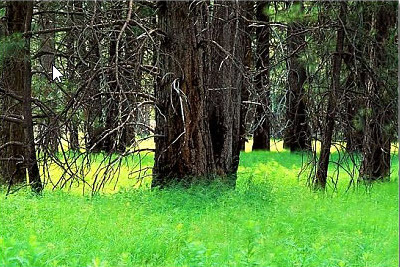
Just about anyone with a camera can and does journey out into nature to photograph "things." So how do we nature photographers see these "things" differently than the countless others when we are photographing the very same subject (s)? Well, what we want to convey with our camera and lens may or may not be what we actually see. This is where knowledge of the camera lens is very valuable information. What we see at the scene is not going to be what goes down on the film. It's the old saying of, "what you see is not what you get" and this applies to photography as well.
So what we are going to do is start to learn how to see more like the lens does? Why do we need to start learning this? Because, if we know what the lens will do to the scene (good or bad), we can make the right lens choice. This will put us in a place of control. We can then employ the lens which will communicate our interpretation of this scene or any scene. Now I am not saying this is a easy thing to do - to see like the lens. And, my little method for learning to see like your lenses see isn't scientific, but it works. It has worked for many photographers who have enrolled in my nature photography workshops.
We have a little exercise you can do if you would like to improve your photographic craft, the part that deals with seeing like your lens.
There are many photographers in history that used successfully only one focal length lens. They were able to do this because of their knowledge of how the particular lens they were using portrayed the subject. Some of these photographers, I’m sure, were limited as to the available funds for equipment, and therefore, due to financial hardship needed to understand their single lens (don't we all). Today, this is a totally different scenario. There are a wide variety of lenses on the market for photographers to use in photography. The different focal lengths available in 35mm alone is more than staggering.
What we will concentrate on are the most widely used and popular lenses. These focal length lenses are the primary choices for landscape photography. Our purpose is to understand how the lens will see our subject so we may use this knowledge when selecting the lens for each image made. The lens you choose is dependent on your knowledge of its use. Do not put one lens on your camera for the day! You will lose so much creativity when doing such a thing, unless of course, you only have the one lens.
20mm-35mm focal length
Using a short focal length lens can cause unwanted distortion. Use care when photographing people. This lens range will give a feeling of place to the image. By this, I mean the viewer will have the feeling of "being there" when looking at the finished picture. You will get the easiest control over depth of field with this choice. The shorter lens is also a good choice for showing a sense of scale. When using filters and/or a lens hood, you must make sure the lens angle of view does not become obstructed. This is very important.
70mm-150mm focal length
This is the lens range I use most. Its use allows for extracting a portion of your scene (tight compositions), which is the intimate portrait in landscape work. You may limit the background coverage with this focal length and it gives more working room (distance) from the subject with some scene compression. Filter use is much easier to work with than the wider focal lengths. The weight of these lenses is still fairly light, unless using very fast lenses (F 2.8). The use of a tripod is now becoming a common occurrence. A tripod should always be in good working order. This means you should maintain your equipment regularly.
The longer lenses are commonly used in wildlife and sports photography. I am not covering them in this article.
At the scene, we have our camera with lens on a tripod, camera loaded with film. We may also have a filter on the lens. From the scene to the film working towards the camera we have the scene, filter, lens, our exposure, film, and lastly, our film processing. In order we have: Processed film, Exposure, Film, Lens, (filter) Subject. The lens is very important when it comes to viewing your subject. It should be the finest piece of glass you can afford. I know quality costs and when it comes to fine optics, don’t cut corners when buying lenses.
To test your lenses to discover how they see your subject, use different focal lengths on the same subject at the same distance. Change your distance and do the same as before. Change the distance one more time and use your lenses again.
As an example: use the following lengths 24mm, 35mm, 70mm, 200mm lenses at a distance of 5 feet, 10 feet, and 25 feet from the subject foreground. Expose three frames with each focal length lens. One at 5 feet, one at 10 feet, one at 25 feet. You should use the focal lengths you have closest to these sizes.
You will begin to see the subject in different perspective (the change in distance always alters the perspective) and you will see a difference in near/far relationships. Near/far relationships are affected as you move closer or farther away from the subject and when you change the focal length of the lens (this is the apparent middle ground and the size of subject matter). Keep the height of your camera constant for evaluation. What you want is an "apples to apples" comparison.
When you have your film processed, mark the slide mounts as to the focal length and distance to subject. You will then place these on the light box and be amazed as the lights come on. Because the Nature Photographers site is of limited space, I didn't post images to show examples with this article. You will have to go out in nature with camera in hand and "see" how your lens sees. Dedicate just one roll of film to this and grow by leaps and bounds.
With the image displayed with this article, you can see I had control of the photographic process and knew the look I wanted. I could only do this knowing which lens to choose to give the desired effect, slight compression. This lens choice the 105mm, pulled the furthest trees into the scene by compression.
#studioserraphotography#san diego photographer#San Diego Photography#landscape photography#professional landscape#photo studio san diego#photography san diego#commercial photography#commercial real estate photography#commercial photography service#fine art photography
0 notes